Spanish Mediterranean house design captures the timeless elegance of coastal European architecture, blending warm stucco walls, terracotta roofing, and graceful archways with modern comfort. This enchanting style emphasizes indoor-outdoor living through courtyards, patios, and expansive terraces that seamlessly connect interior spaces with lush gardens. Characterized by natural materials, wrought iron details, and drought-tolerant landscaping, these homes create inviting retreats that celebrate both tradition and contemporary functionality. From rustic hacienda-inspired exteriors to sophisticated modern interpretations, Spanish Mediterranean design offers endless possibilities for creating homes that embody the relaxed luxury of Mediterranean coastal living.
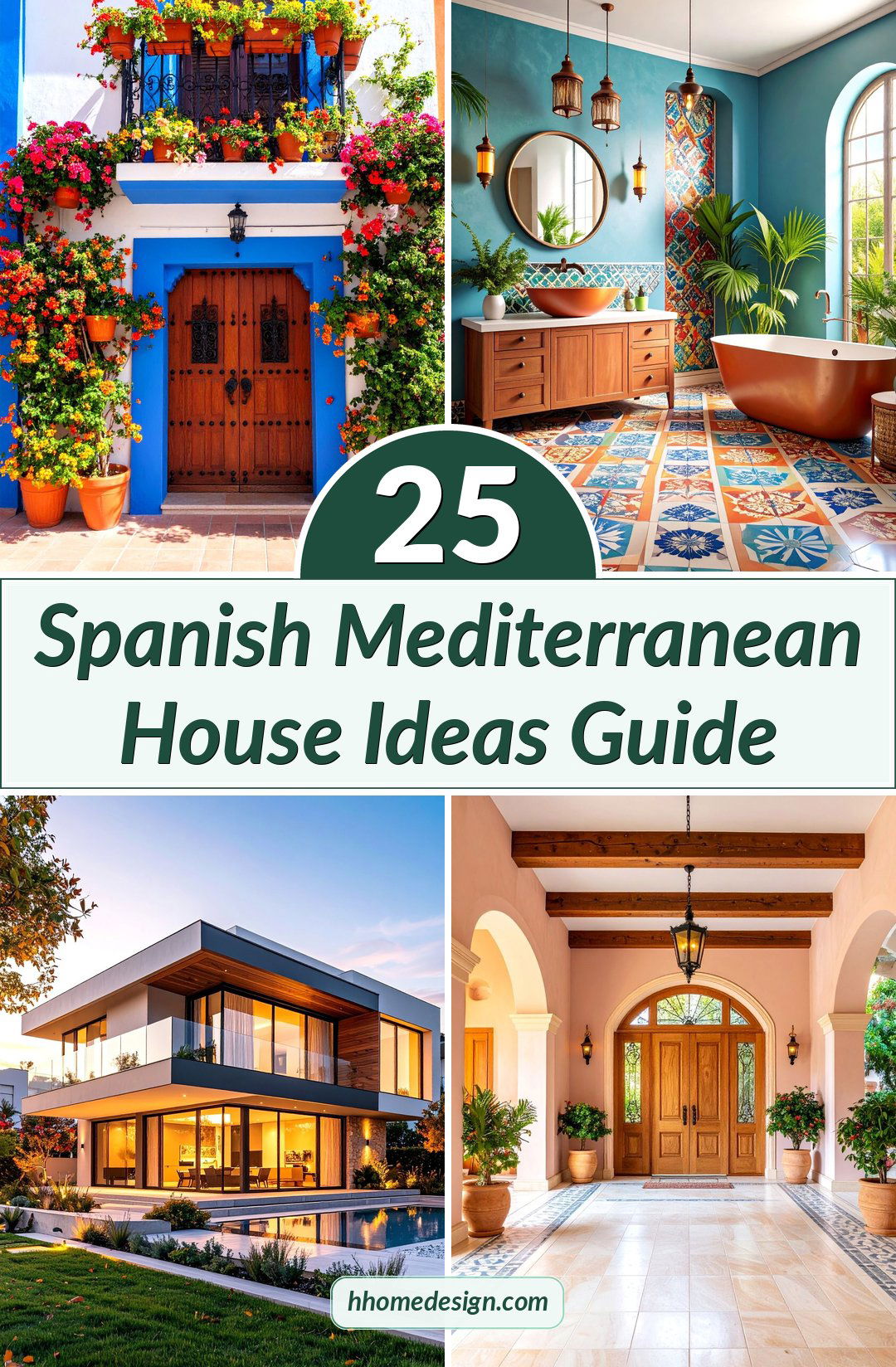
1. Traditional White Stucco Hacienda with Terracotta Roofing
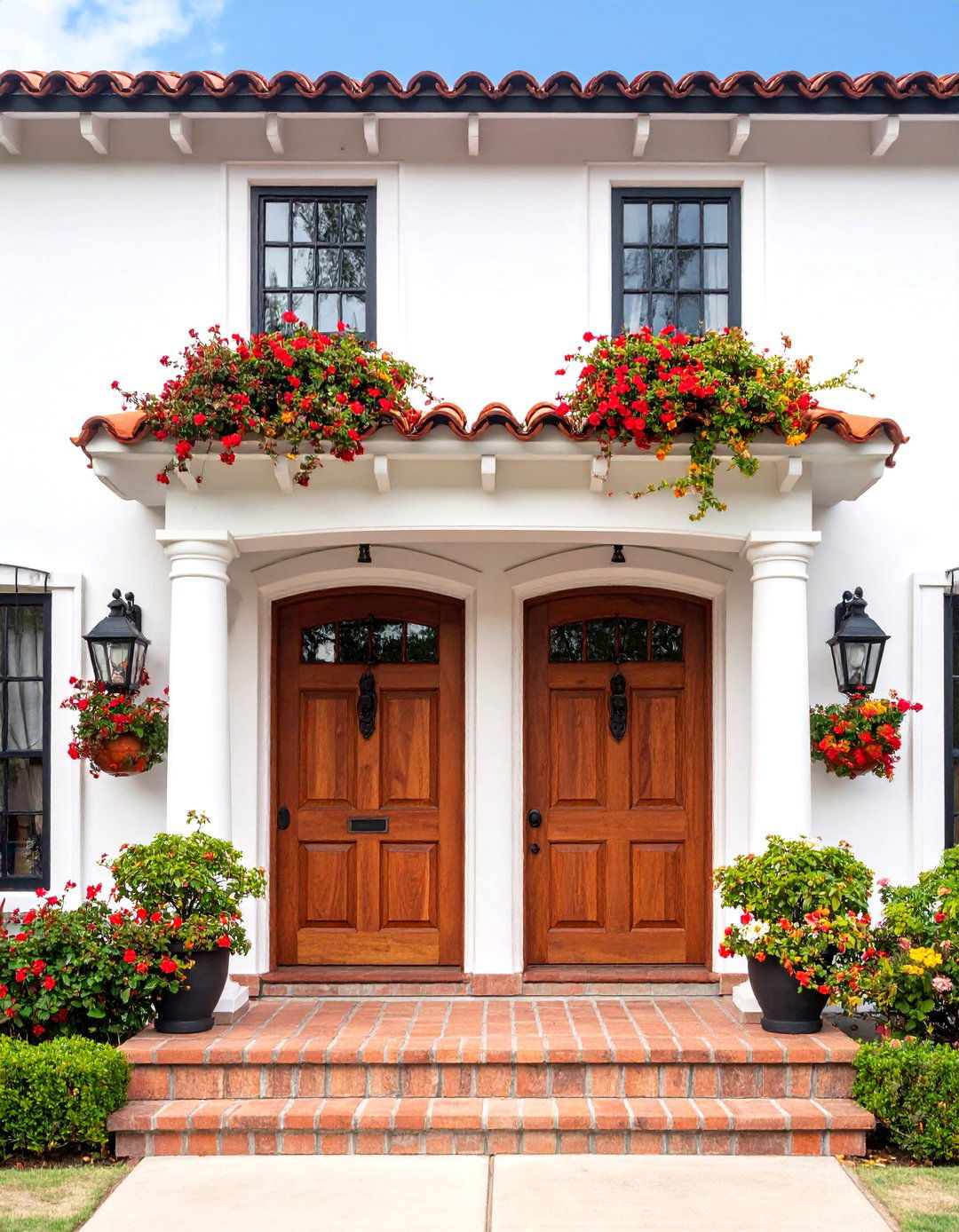
Classic Spanish Mediterranean architecture showcases pristine white stucco exteriors paired with distinctive red terracotta tile roofing that creates timeless curb appeal. This traditional approach features thick stucco walls with hand-troweled finishes that develop beautiful patina over time, while clay barrel tiles provide excellent insulation and weather resistance. Arched doorways and windows with dark wooden frames create striking contrast against bright walls, while wrought iron window grilles add authentic Spanish colonial character. The combination of materials reflects sunlight effectively, keeping interiors naturally cool while maintaining the iconic Mediterranean aesthetic. Small decorative details like carved wooden doors, stone trim around openings, and strategically placed architectural niches enhance the overall authenticity and visual interest of this enduring design approach.
2. Modern Spanish Mediterranean with Geometric Lines

Contemporary interpretations of Spanish Mediterranean style blend traditional elements with sleek modern geometry, creating sophisticated homes that honor heritage while embracing current design trends. Clean-lined stucco exteriors in warm neutral tones provide backdrop for large picture windows and minimalist metal accents that add contemporary flair. Traditional terracotta roofing remains prominent, but simplified in pattern and complemented by streamlined architectural details. Open floor plans maximize natural light flow while maintaining the essential indoor-outdoor connection through expansive sliding glass doors. Modern materials like steel and glass integrate seamlessly with classic stucco and tile, creating visual depth and textural interest. This approach appeals to homeowners seeking Mediterranean warmth with today's architectural sophistication and energy-efficient features.
3. Courtyard-Centered Spanish Colonial Design
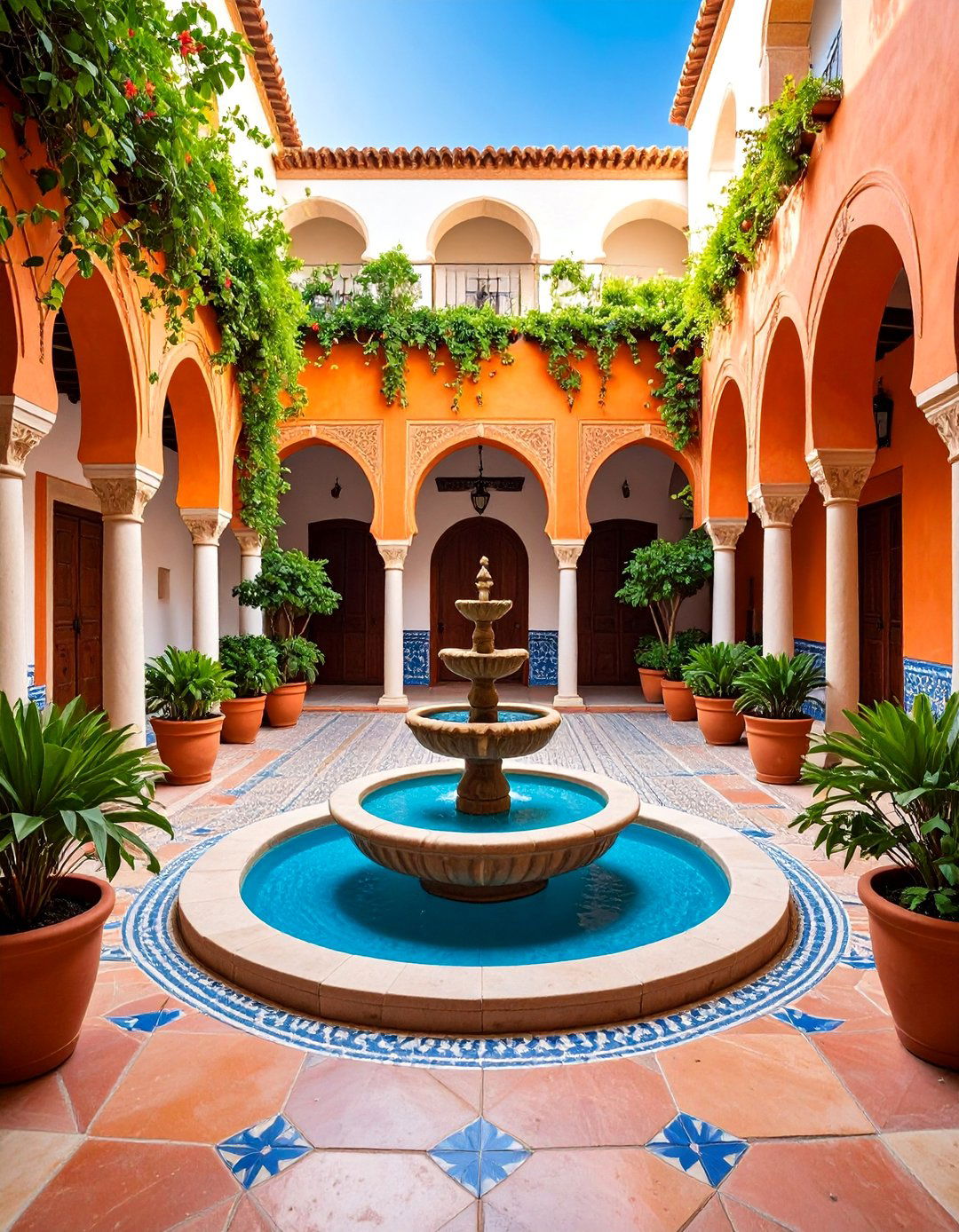
Central courtyards represent the heart of authentic Spanish Mediterranean homes, creating private outdoor sanctuaries that serve as natural gathering spaces for family and entertaining. These enclosed patios feature flagstone or decorative tile flooring surrounded by colonnade-style covered walkways that provide shade and architectural rhythm. Traditional fountains become focal points, offering cooling water sounds and visual tranquility while reflecting the Moorish influences that shaped Spanish design. Surrounding rooms open directly onto the courtyard through French doors or arched openings, blurring interior-exterior boundaries and promoting natural ventilation. Carefully planned landscaping includes drought-tolerant plants in terracotta containers, climbing vines on pergola structures, and strategically placed citrus trees that provide both beauty and functionality. This design creates intimate outdoor living spaces perfect for year-round use in warm climates.
4. Spanish Mediterranean with Exposed Wooden Beams

Dramatic exposed wooden ceiling beams define authentic Spanish Mediterranean interiors, adding rustic elegance and structural visual interest to living spaces. Dark-stained timber beams contrast beautifully against white or cream-colored plaster walls, creating the signature look that connects these homes to their historical roots. These architectural elements serve both aesthetic and practical purposes, originally providing structural support while now offering design authenticity and visual warmth. Beam configurations vary from simple parallel layouts to intricate coffered patterns that add sophisticated detail to dining rooms and great rooms. The rich wood tones complement other Mediterranean materials like terracotta tiles, wrought iron fixtures, and natural stone accents. Modern interpretations may use lightweight alternatives or pre-finished beams that capture the authentic appearance while meeting contemporary building requirements and energy efficiency standards.
5. Wrought Iron Accented Spanish Villa
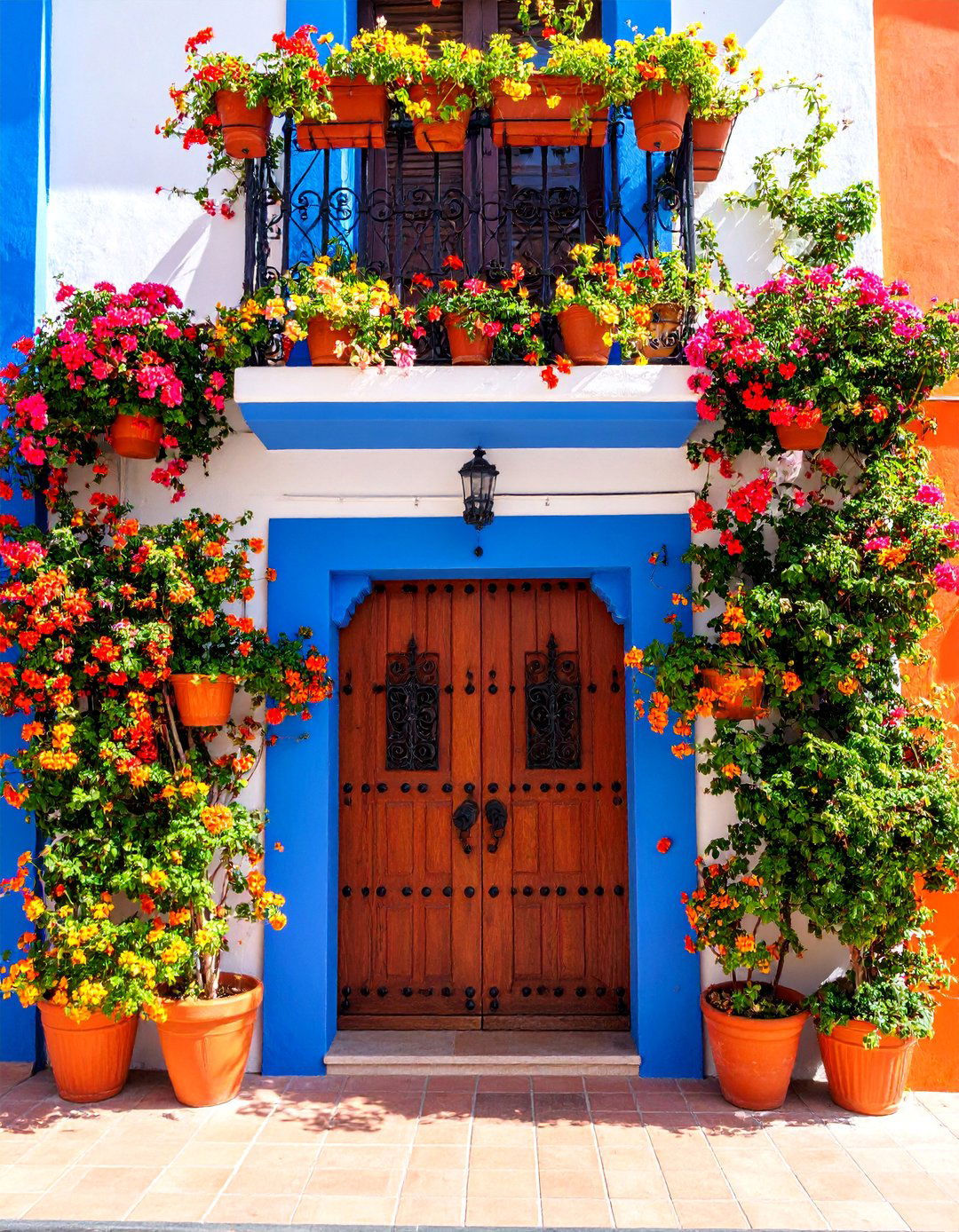
Ornate wrought iron details distinguish Spanish Mediterranean homes through decorative elements that showcase traditional metalworking artistry and provide functional beauty. Intricate window grilles, balcony railings, and gate designs feature scrolling patterns and geometric motifs that reflect Moorish influences on Spanish architecture. Heavy wooden doors enhanced with iron hardware, decorative hinges, and artistic knockers create impressive entries that welcome guests with old-world charm. Interior spaces incorporate wrought iron through chandeliers, stair railings, and decorative wall fixtures that maintain design continuity throughout the home. Garden areas benefit from iron arbors, trellises, and decorative fencing that support climbing plants while adding sculptural elements to outdoor spaces. These metalwork details require careful craftsmanship and regular maintenance but provide lasting beauty and authentic Spanish character that elevates the entire design aesthetic.
6. Arched Window and Doorway Spanish Design

Graceful archways represent fundamental Spanish Mediterranean architectural elements, creating flowing transitions between spaces while honoring centuries of design tradition. True Roman arches in doorways and windows provide structural beauty and historical authenticity, often featuring stone or tile surrounds that add textural contrast to stucco walls. Multiple arched openings in sequence create stunning visual rhythm along covered walkways, patios, and interior corridors. These curved elements soften the overall architectural composition while maintaining the style's characteristic elegance and proportional harmony. Interior arched passages between rooms promote natural light flow and spatial continuity essential to Mediterranean living. Keystone details, decorative tile accents, and varying arch heights add visual interest while maintaining structural integrity. This design approach works equally well in traditional and contemporary interpretations, providing timeless appeal that enhances both curb appeal and interior functionality.
7. Spanish Mediterranean Outdoor Kitchen and Dining
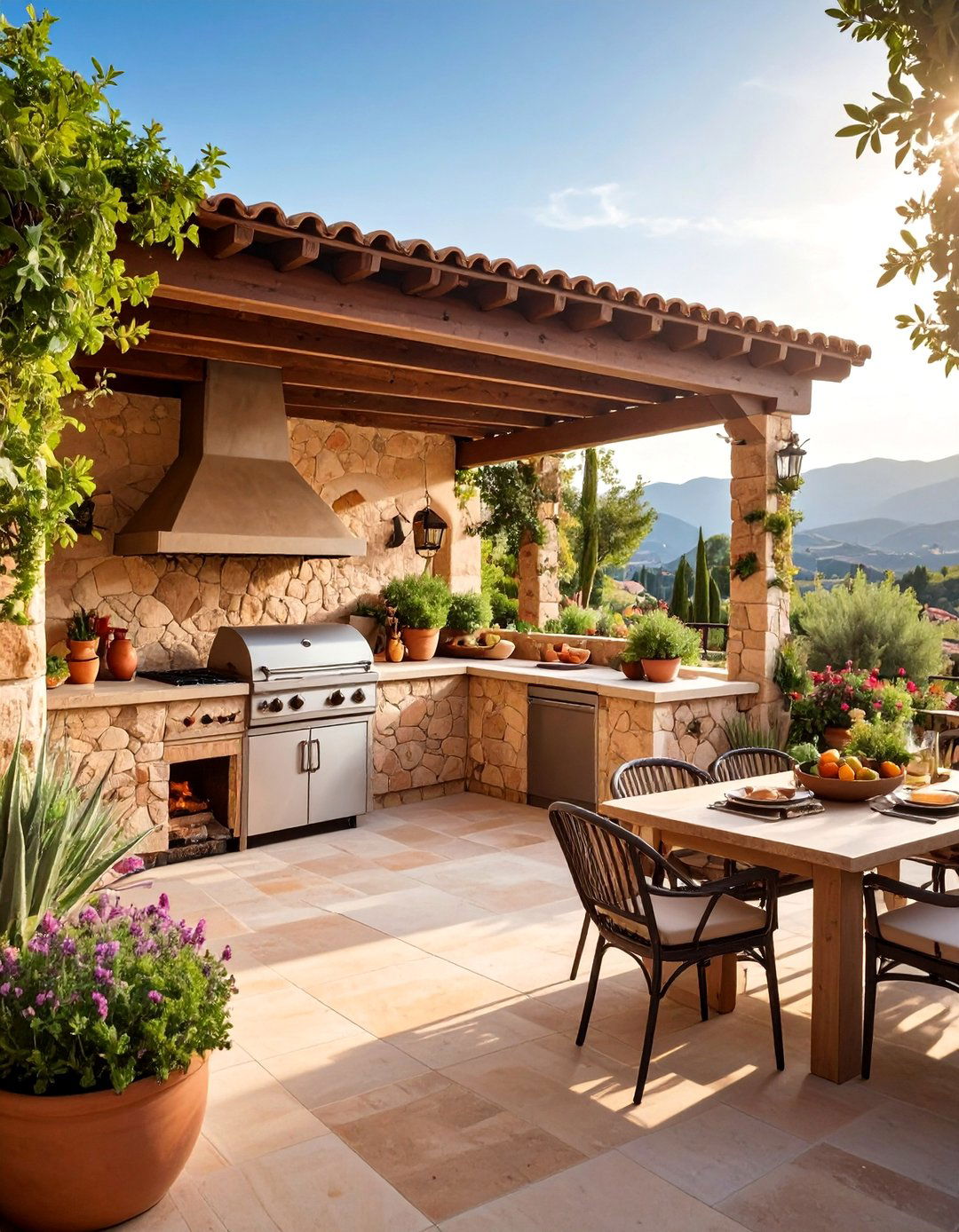
Expansive outdoor cooking and dining areas embody the Spanish Mediterranean emphasis on al fresco living and year-round entertaining in favorable climates. These spaces feature built-in grills, wood-fired pizza ovens, and preparation areas constructed with natural stone and decorative tile that complement the home's architectural style. Covered pergolas or loggia-style roofing provide necessary shade while maintaining open-air ambiance essential to Mediterranean outdoor living. Comfortable seating arrangements include both casual dining areas and formal tables positioned to take advantage of garden views and evening breezes. Ambient lighting through wrought iron fixtures, string lights, or built-in illumination extends usability into evening hours. Water features, herb gardens, and container plantings create sensory richness while providing fresh ingredients for outdoor cooking. These outdoor rooms function as extensions of interior living spaces, complete with weather-resistant furnishings and storage solutions.
8. Patterned Tile Spanish Mediterranean Bathroom

Vibrant hand-painted tiles transform Spanish Mediterranean bathrooms into luxurious retreats that celebrate color, pattern, and artisanal craftsmanship. Traditional ceramic tiles featuring geometric patterns, floral motifs, or Moorish-inspired designs create stunning focal points on walls, shower surrounds, and vanity backsplashes. Rich blues, warm terracottas, deep greens, and golden yellows reflect the Mediterranean palette while adding personality and visual warmth to these private spaces. Natural stone flooring in travertine or limestone provides neutral foundation that complements colorful tile work without competing for attention. Wrought iron fixtures, carved wooden vanities, and hammered copper or ceramic vessel sinks enhance the authentic Spanish aesthetic. Large mirrors with decorative frames, arched windows for natural light, and carefully planned lighting create spa-like atmospheres perfect for relaxation. These bathrooms balance function with beauty, incorporating modern amenities within traditional design frameworks.
9. Spanish Colonial Revival Living Room
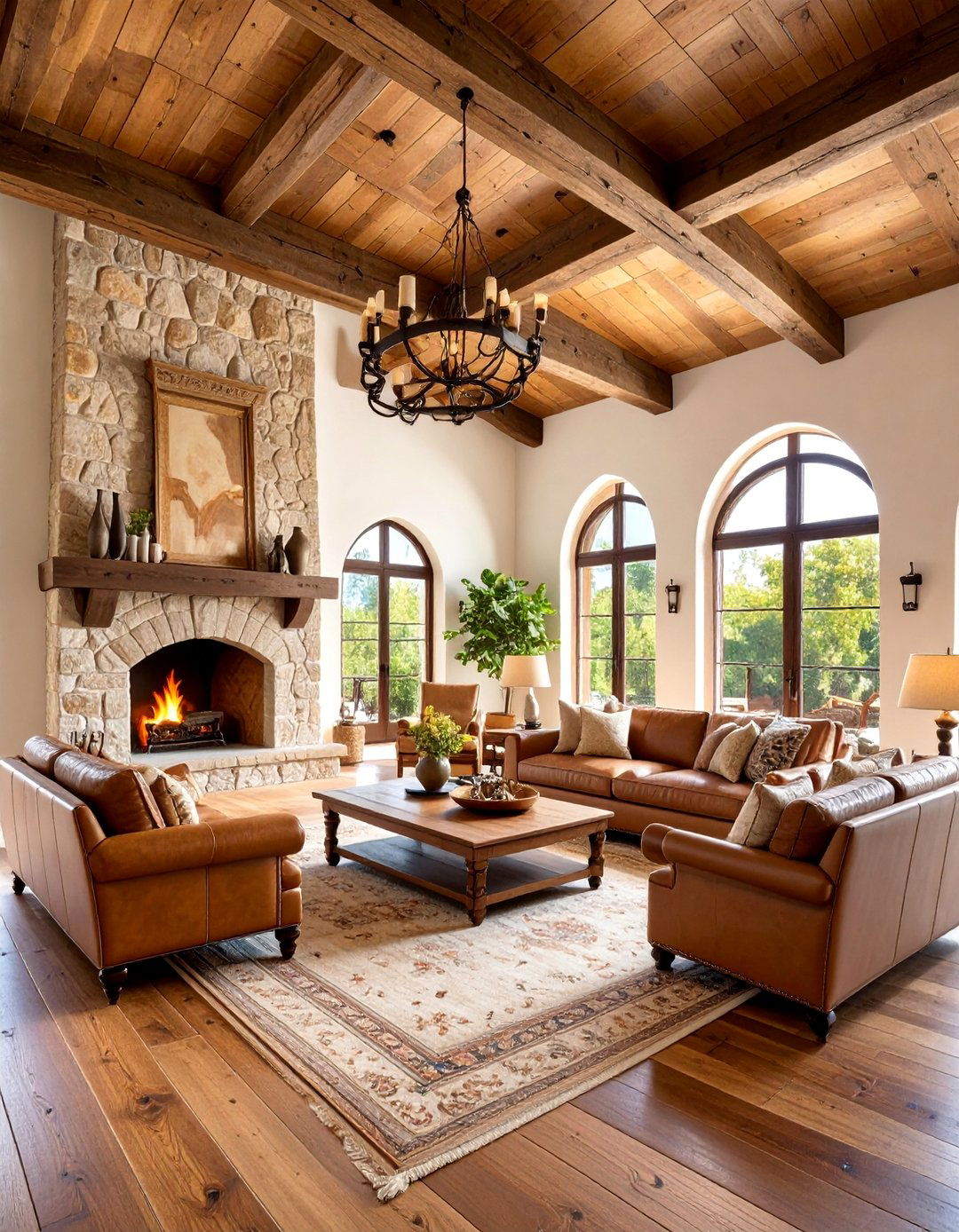
Grand Spanish Mediterranean living rooms feature soaring ceilings, natural materials, and carefully curated furnishings that create sophisticated yet comfortable gathering spaces for family and guests. Exposed wooden beams, stone or tile fireplaces, and textured plaster walls provide architectural foundation for layered interior design that honors Spanish traditions. Neutral color palettes in warm whites, creams, and earth tones allow accent colors in textiles, artwork, and decorative objects to create visual interest without overwhelming the space. Comfortable seating arrangements include leather sofas, carved wooden furniture, and wrought iron accessories that maintain style consistency throughout the room. Large windows, French doors to patios, and strategic lighting maximize natural light while providing connections to outdoor living areas. Area rugs with traditional patterns, pottery collections, and carefully chosen artwork complete these spaces that balance formality with the relaxed Mediterranean lifestyle.
10. Drought-Tolerant Spanish Mediterranean Landscaping

Sustainable Spanish Mediterranean gardens feature carefully selected drought-resistant plants that thrive in arid climates while maintaining lush, colorful appeal throughout the year. Native and adapted species including lavender, rosemary, olive trees, and ornamental grasses provide texture, fragrance, and visual interest without requiring extensive irrigation. Gravel pathways, natural stone retaining walls, and decomposed granite surfaces replace water-hungry lawns while adding authentic Mediterranean character to outdoor spaces. Terraced planting areas maximize slope stability and create varied growing conditions for different plant types. Efficient drip irrigation systems and strategic shade structures support plant health while minimizing water consumption. Container gardens in terracotta pots allow seasonal color changes and flexibility in garden design. These landscapes celebrate the natural beauty of Mediterranean plants while creating sustainable outdoor environments that complement Spanish architectural styles and support local ecosystems.
11. Rustic Spanish Farmhouse Kitchen Design
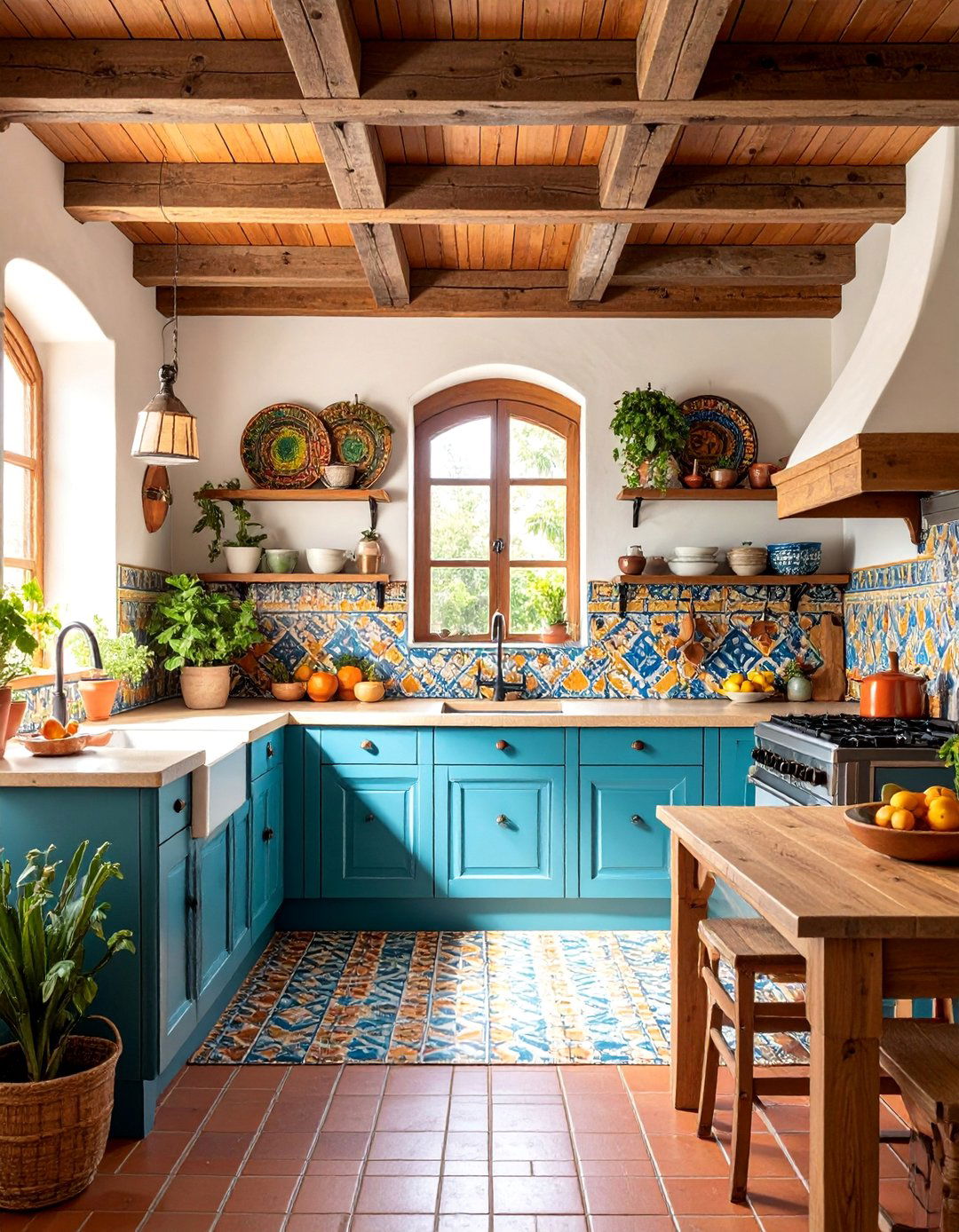
Authentic Spanish Mediterranean kitchens combine functionality with rustic charm through natural materials, traditional craftsmanship, and time-honored design principles. Hand-painted ceramic tiles create colorful backsplashes that serve as focal points while protecting walls from cooking splashes. Exposed wooden beams, stone or brick accents, and plaster range hoods add architectural interest and historical authenticity to these working spaces. Warm-toned cabinetry in natural wood or painted finishes provides ample storage while maintaining the Spanish aesthetic through decorative hardware and traditional proportions. Large farmhouse sinks, tile countertops, and wrought iron fixtures complete the authentic look while meeting modern cooking requirements. Central islands or preparation tables offer additional workspace and casual dining options that support the Mediterranean emphasis on gathering around food. These kitchens balance old-world charm with contemporary appliances and conveniences, creating spaces that honor tradition while serving today's lifestyle needs.
12. Spanish Mediterranean Master Bedroom Retreat
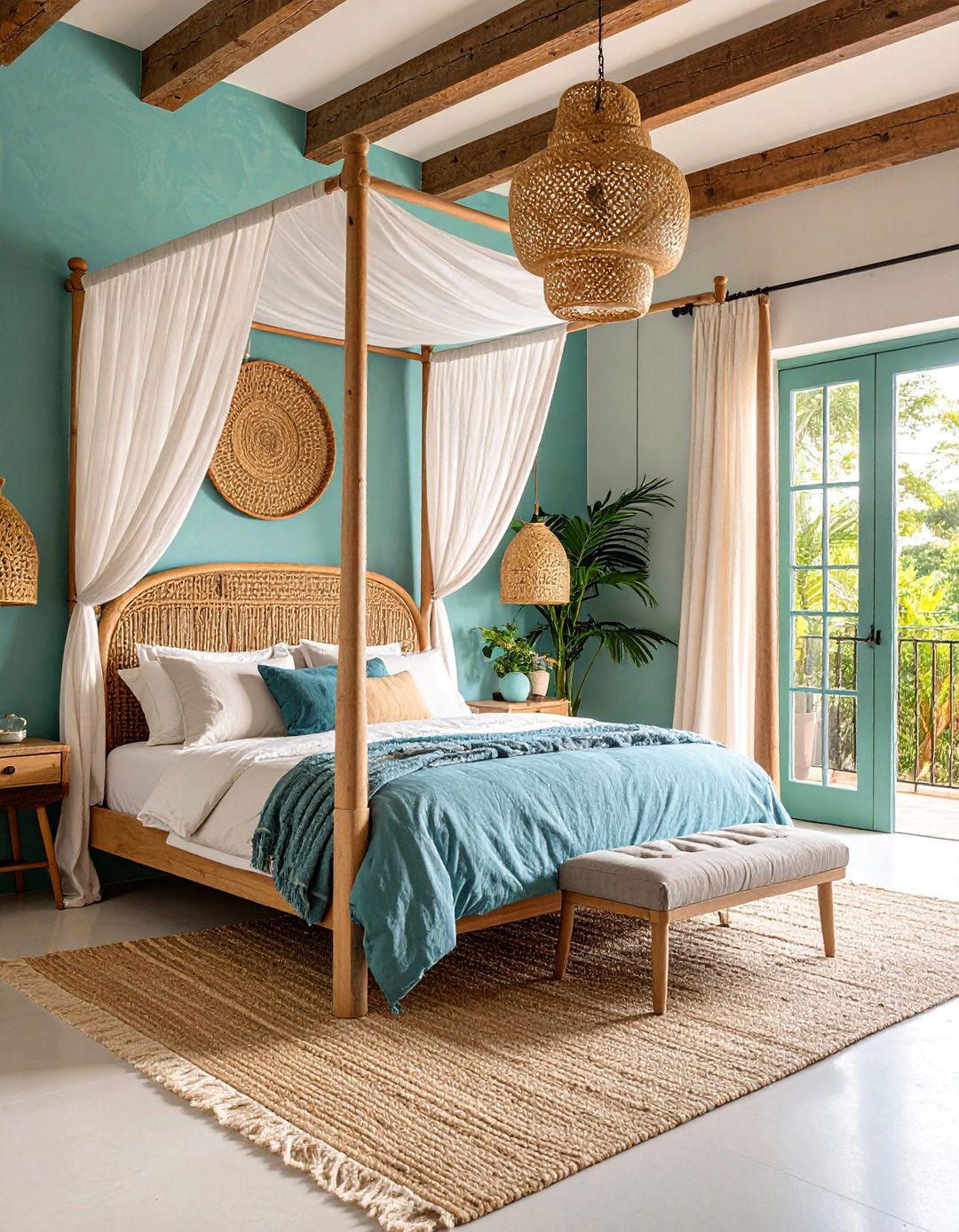
Luxurious Spanish Mediterranean master bedrooms create serene retreats that emphasize comfort, natural materials, and connections to outdoor spaces. Textured plaster walls in warm neutral tones provide calming backdrops for carefully chosen furnishings that reflect Spanish craftsmanship and design traditions. Four-poster beds with wrought iron or carved wooden frames become focal points, often dressed in natural linen bedding that enhances the relaxed Mediterranean aesthetic. French doors opening to private balconies or garden patios extend living space outdoors while providing natural light and cross-ventilation. Decorative tile accents, exposed ceiling beams, and stone or tile flooring add architectural interest without overwhelming these peaceful spaces. Built-in storage, reading nooks, and sitting areas increase functionality while maintaining the room's spacious, uncluttered feel. Ambient lighting through table lamps, wall sconces, and natural light creates layered illumination perfect for relaxation and rest.
13. Terrace and Balcony Spanish Design
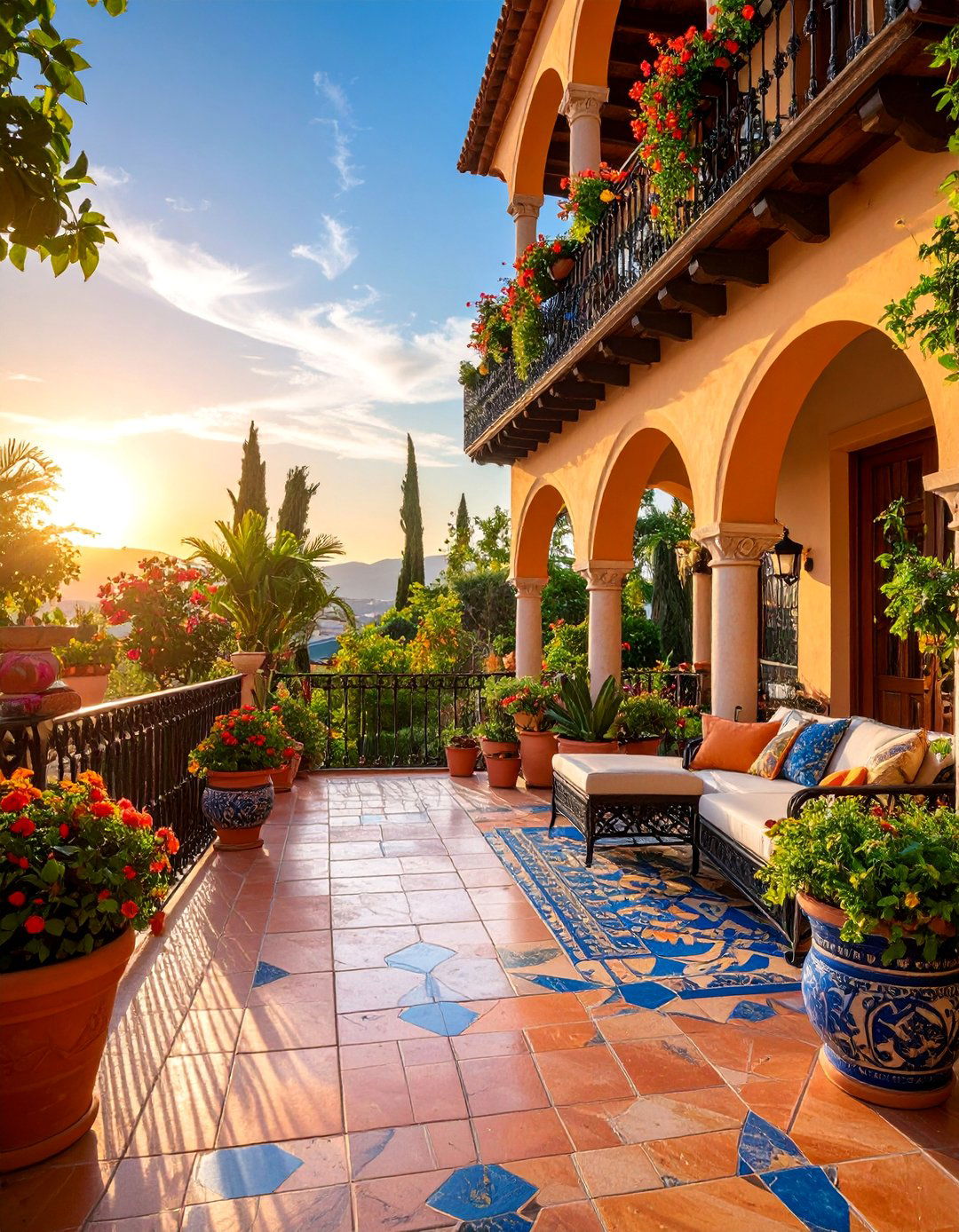
Multi-level terraces and decorative balconies maximize outdoor living opportunities while creating dramatic architectural features that enhance Spanish Mediterranean homes' visual appeal. Upper-level balconies with ornate wrought iron railings provide private outdoor retreats and commanding views of gardens and surrounding landscapes. These elevated spaces often feature comfortable seating, container gardens, and weather-resistant furnishings that extend interior living outdoors. Ground-level terraces incorporate natural stone or tile flooring, built-in seating, and integrated planters that seamlessly blend hardscape with landscape elements. Strategic placement takes advantage of prevailing breezes, sun patterns, and privacy considerations while maintaining visual connections between different outdoor areas. Covered sections provide shade during intense sun while open areas allow for sunbathing and stargazing. These outdoor rooms function year-round in appropriate climates, offering flexibility for both intimate gatherings and larger entertaining scenarios that celebrate the Mediterranean outdoor lifestyle.
14. Spanish Revival Entry and Foyer

Grand Spanish Mediterranean entries create impressive first impressions through carefully planned architectural elements that welcome guests while establishing the home's design character. Massive wooden doors, often featuring carved panels and wrought iron hardware, open into spacious foyers with stone or tile flooring that can withstand traffic while maintaining beauty. Dramatic ceiling treatments including exposed beams, decorative plasterwork, or painted designs add visual interest and height to these transitional spaces. Natural light enters through transom windows, sidelights, or skylights that illuminate architectural details while reducing reliance on artificial lighting. Built-in benches, decorative niches, and carefully placed artwork create functional beauty that serves daily needs while impressing visitors. Staircase designs featuring wrought iron railings, tile risers, or stone treads continue the Spanish theme while providing elegant access to upper levels. These entries set the tone for the entire home while providing practical spaces for daily comings and goings.
15. Mosaic and Decorative Tile Features
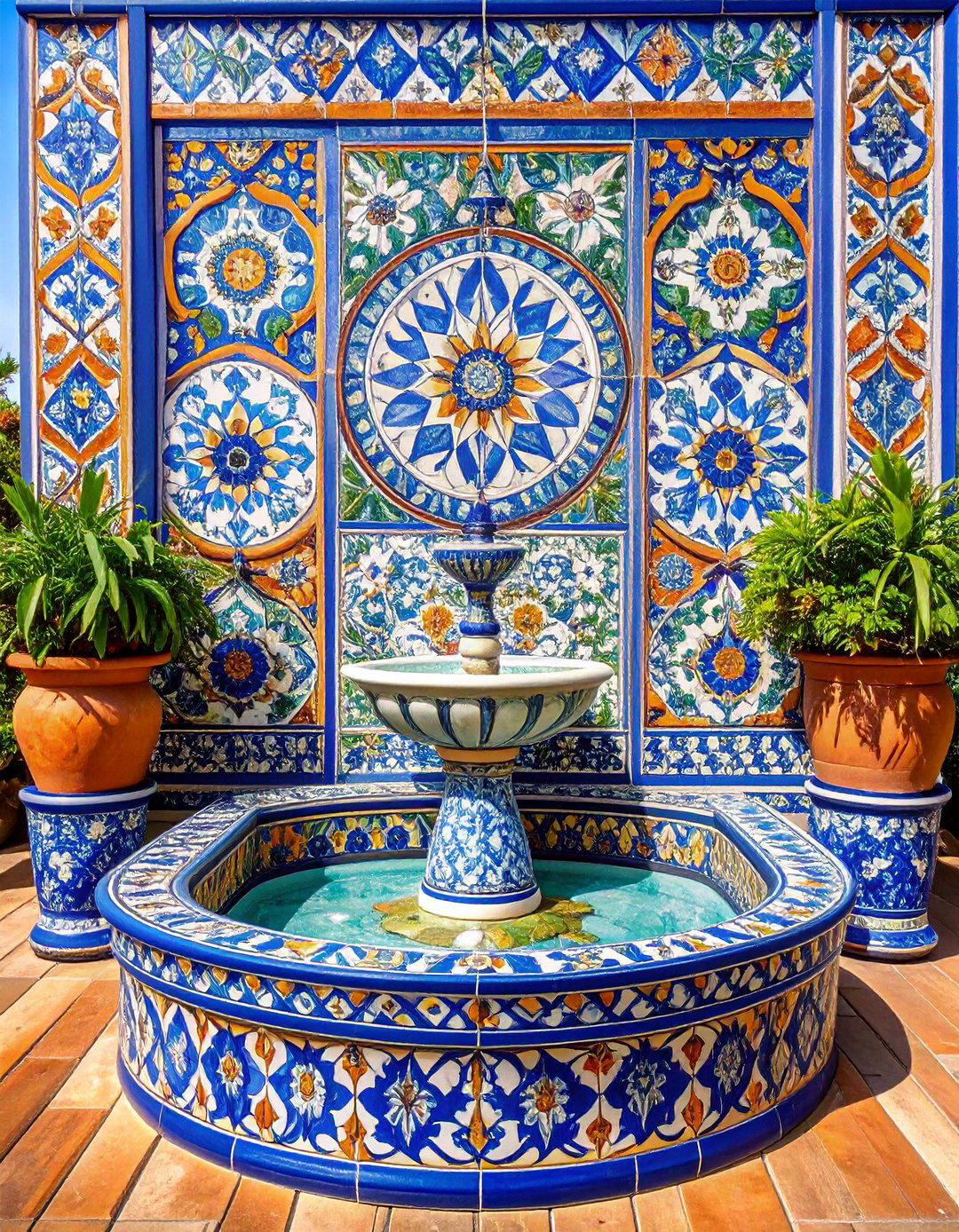
Intricate mosaic work and decorative tile installations showcase Spanish Mediterranean homes' commitment to artisanal craftsmanship and cultural heritage. These detailed applications appear in fountain designs, stair risers, fireplace surrounds, and accent walls that add color, pattern, and textural interest throughout indoor and outdoor spaces. Traditional geometric patterns reflect Moorish influences while floral and nature-inspired designs celebrate Spanish artistic traditions. Pool areas, outdoor kitchens, and bathroom installations benefit from tile's durability and water resistance while maintaining authentic aesthetic appeal. Color palettes typically include rich blues, warm terracottas, deep greens, and golden yellows that complement neutral stucco and stone elements. Contemporary interpretations may simplify patterns or use modern materials while maintaining the essential Spanish character. These decorative elements require skilled installation and careful maintenance but provide lasting beauty that increases property value while honoring Mediterranean design traditions.
16. Covered Loggia and Pergola Spaces
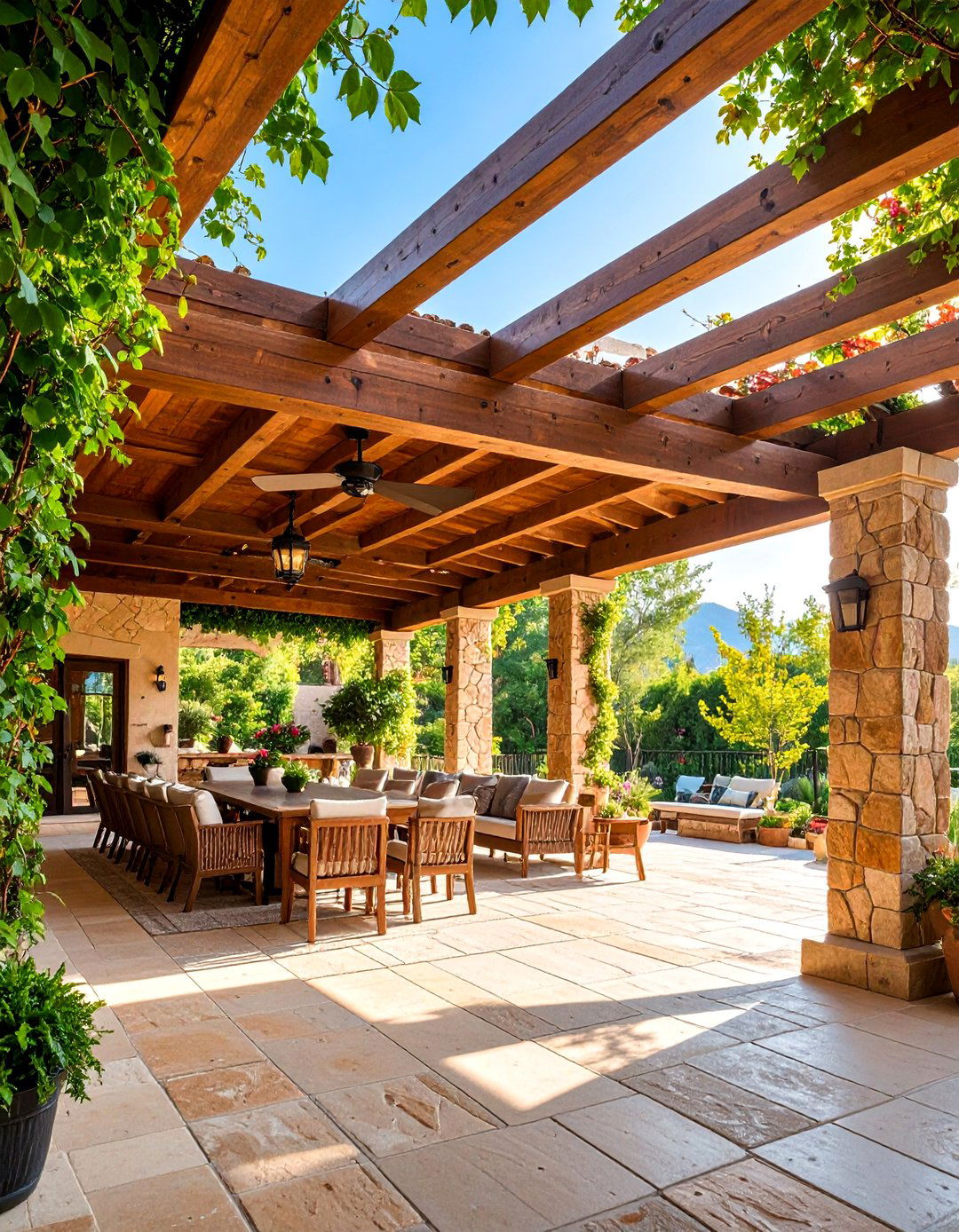
Covered outdoor living areas including loggias and pergolas provide essential shade while creating architectural definition that enhances Spanish Mediterranean homes' indoor-outdoor connection. These structures feature stone or tile columns, exposed wooden beams, and careful proportions that complement the main house's architectural style. Climbing vines such as bougainvillea, jasmine, or grape vines add natural beauty while providing additional shade and privacy as they mature. Comfortable furnishing arrangements include outdoor sofas, dining sets, and casual seating that accommodate various activities from quiet reading to festive entertaining. Built-in features such as outdoor fireplaces, ceiling fans, and integrated lighting extend usability throughout different seasons and times of day. These covered spaces often connect to interior rooms through large openings that promote natural ventilation and spatial flow. Careful attention to materials, scale, and details ensures these outdoor rooms feel like natural extensions of interior living areas.
17. Spanish Mediterranean Swimming Pool Design
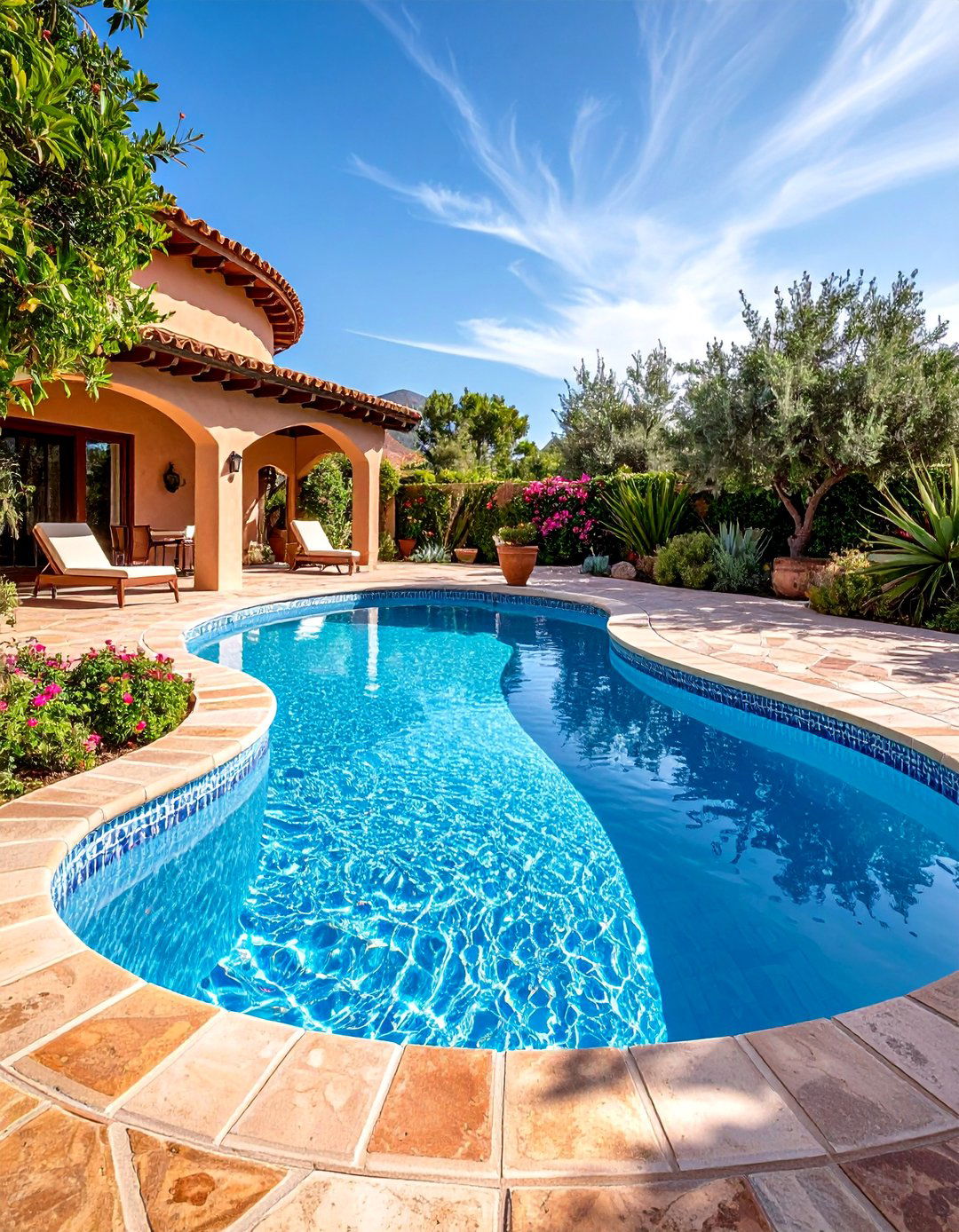
Resort-style swimming pools embrace Spanish Mediterranean design through natural materials, traditional tile work, and landscape integration that creates backyard paradises. Saltillo tile coping, natural stone decking, and mosaic tile finishes in blues and earth tones complement the home's architectural palette while providing slip-resistant, durable surfaces. Pool shapes often incorporate curved lines and naturalistic forms rather than strict geometric patterns, creating more organic integration with landscape elements. Water features including fountains, spillways, and decorative tile work add visual and auditory interest while referencing traditional Spanish water gardens. Surrounding landscape includes drought-tolerant plants, terracotta containers, and stone accents that require minimal maintenance while providing year-round beauty. Covered seating areas, outdoor kitchens, and fire features create complete outdoor living environments centered around the pool. These aquatic retreats support the Mediterranean lifestyle's emphasis on relaxation, entertainment, and connection with outdoor environments.
18. Interior Courtyard Garden Room
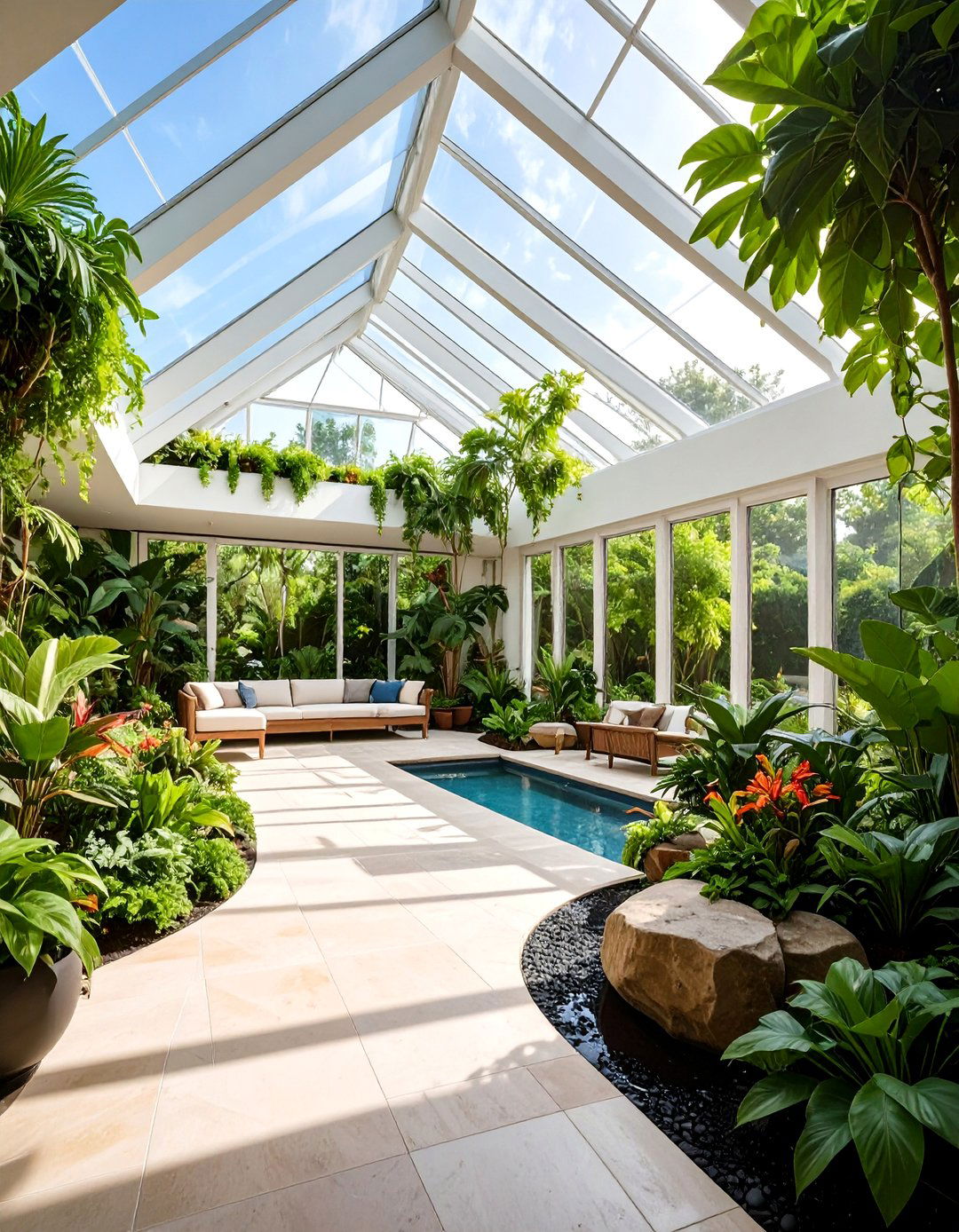
Glass-enclosed interior courtyards bring Mediterranean garden beauty indoors while providing year-round enjoyment regardless of climate constraints. These indoor garden rooms feature climate-controlled environments that support tropical and Mediterranean plants while flooding interior spaces with natural light. Skylights, clerestory windows, and glass walls maximize daylight penetration while protecting plants and furnishings from weather extremes. Stone or tile flooring provides durable, water-resistant surfaces that handle plant care activities while maintaining aesthetic appeal. Water features, sculpture, and decorative tile work create focal points that enhance the garden atmosphere. Surrounding rooms benefit from garden views and natural light while maintaining climate comfort through efficient HVAC systems. These spaces serve multiple functions including meditation retreats, reading areas, and indoor entertainment spaces that celebrate nature year-round. Proper ventilation, drainage, and plant selection ensure healthy growing conditions while minimizing maintenance requirements.
19. Spanish Colonial Fireplace Design
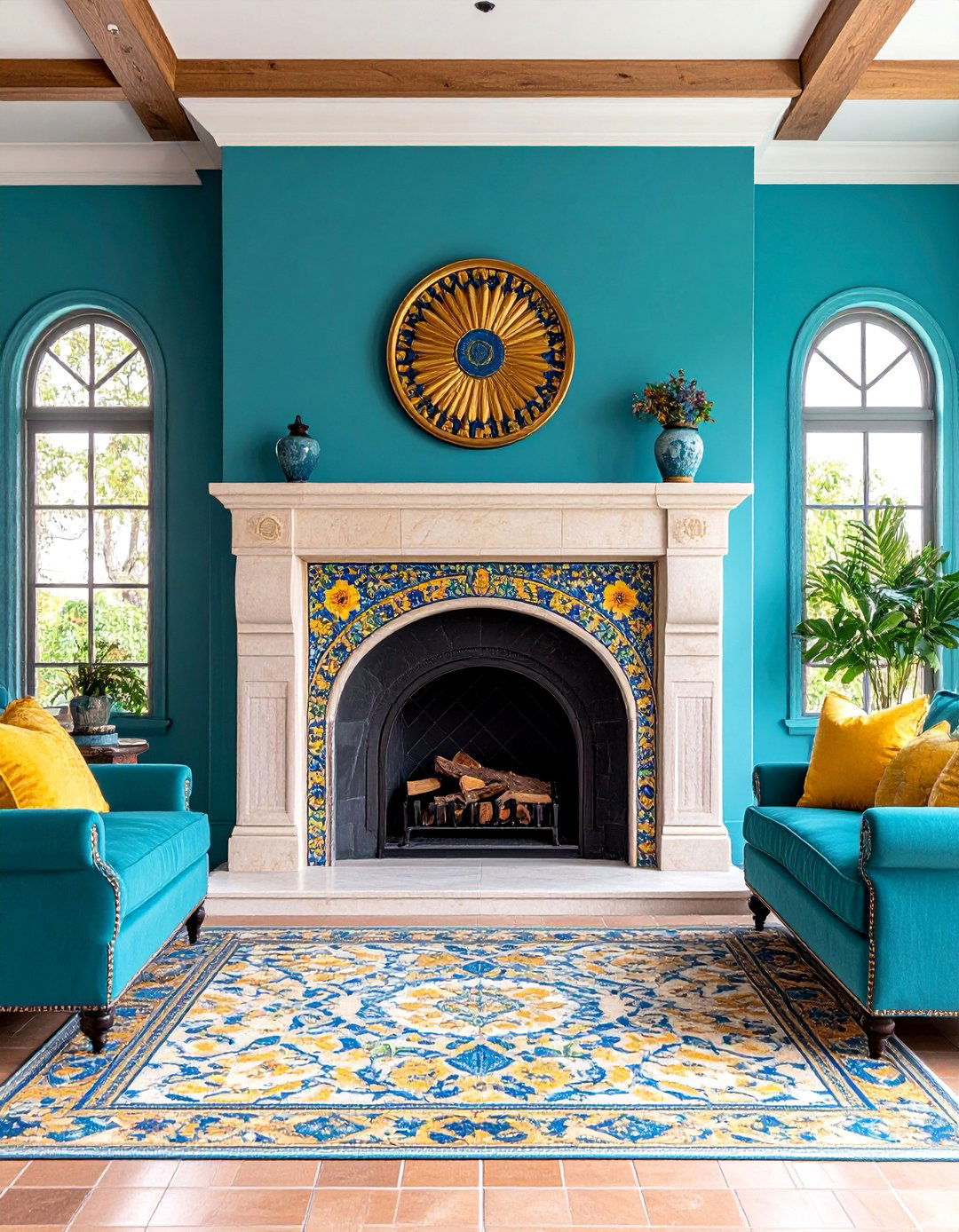
Dramatic fireplace designs anchor Spanish Mediterranean living spaces through impressive scale, natural materials, and traditional craftsmanship that create gathering focal points. Stone surrounds, decorative tile accents, and plastered chimney breasts provide textural richness while maintaining authentic Spanish character. Raised hearths offer additional seating while built-in wood storage and decorative niches add functionality and visual interest. Mantel designs range from simple stone shelves to elaborate carved wooden pieces that support decorative objects and seasonal displays. Many Spanish fireplaces feature arched openings that echo the home's window and doorway treatments, creating design continuity throughout interior spaces. Outdoor fireplace designs extend living areas into gardens and patios while providing warmth during cooler evenings. These heating elements serve practical purposes while creating architectural drama that enhances both formal and casual entertaining scenarios. Proper sizing, ventilation, and safety features ensure optimal performance and code compliance.
20. Earth-Toned Spanish Mediterranean Color Palette
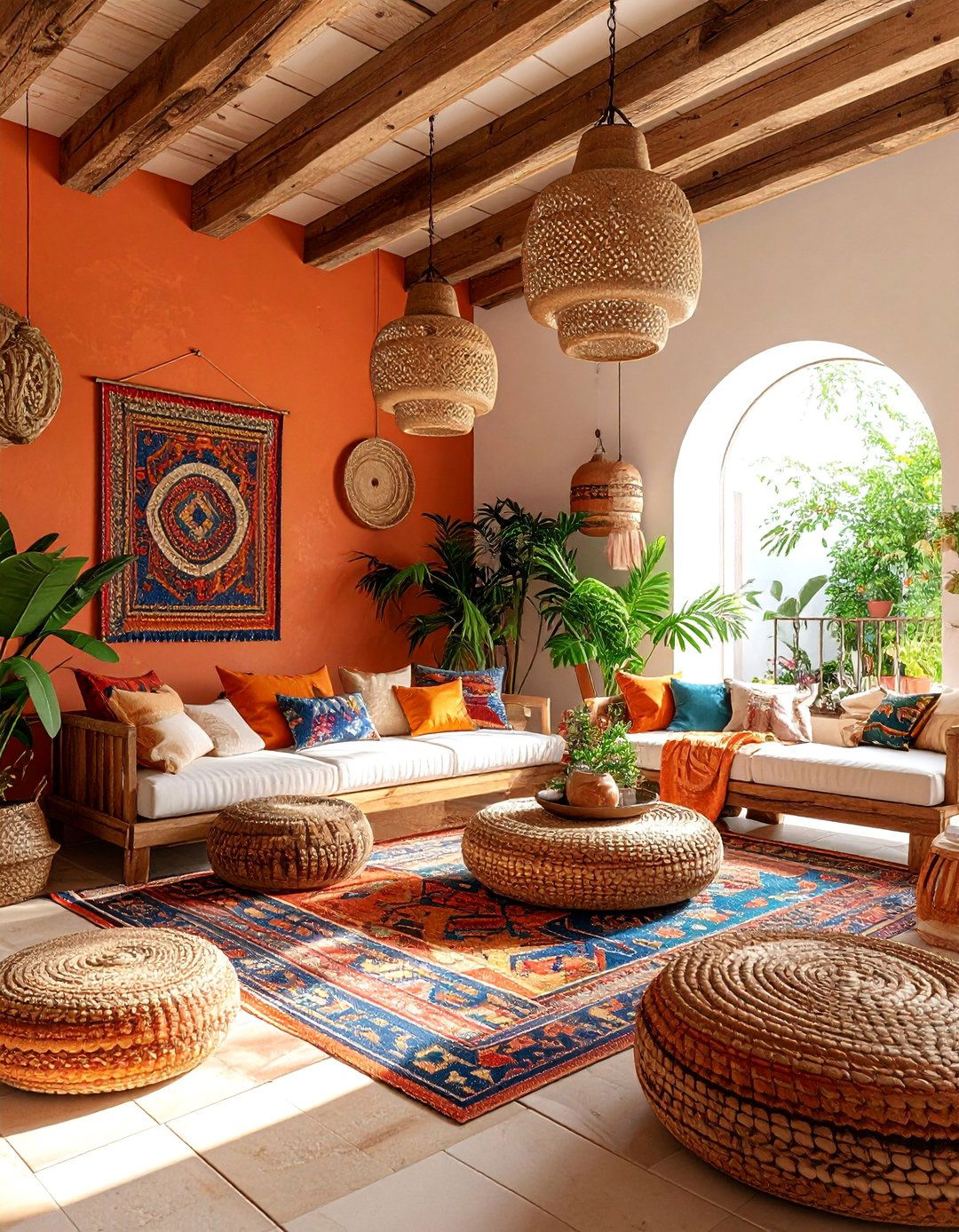
Warm earth-tone color schemes capture the essence of Spanish Mediterranean design through natural palettes that reflect the region's landscape and architectural traditions. Creamy whites, soft beiges, warm terracottas, and golden ochres provide neutral foundations that complement natural materials while creating inviting, sun-soaked atmospheres. Accent colors including deep blues, sage greens, and rich burgundies add depth and interest without overwhelming the calm, sophisticated base palette. These colors work beautifully with natural materials including stone, wood, and tile while providing flexibility for seasonal decorative changes. Exterior applications maintain visual harmony while interior spaces can incorporate bolder accent colors through textiles, artwork, and decorative accessories. Color selection considers natural light conditions, room orientation, and intended use to create optimal visual comfort and aesthetic appeal. Professional color consultation ensures harmonious combinations that enhance architectural features while supporting the overall Mediterranean design vision.
21. Spanish Mediterranean Guest Casita
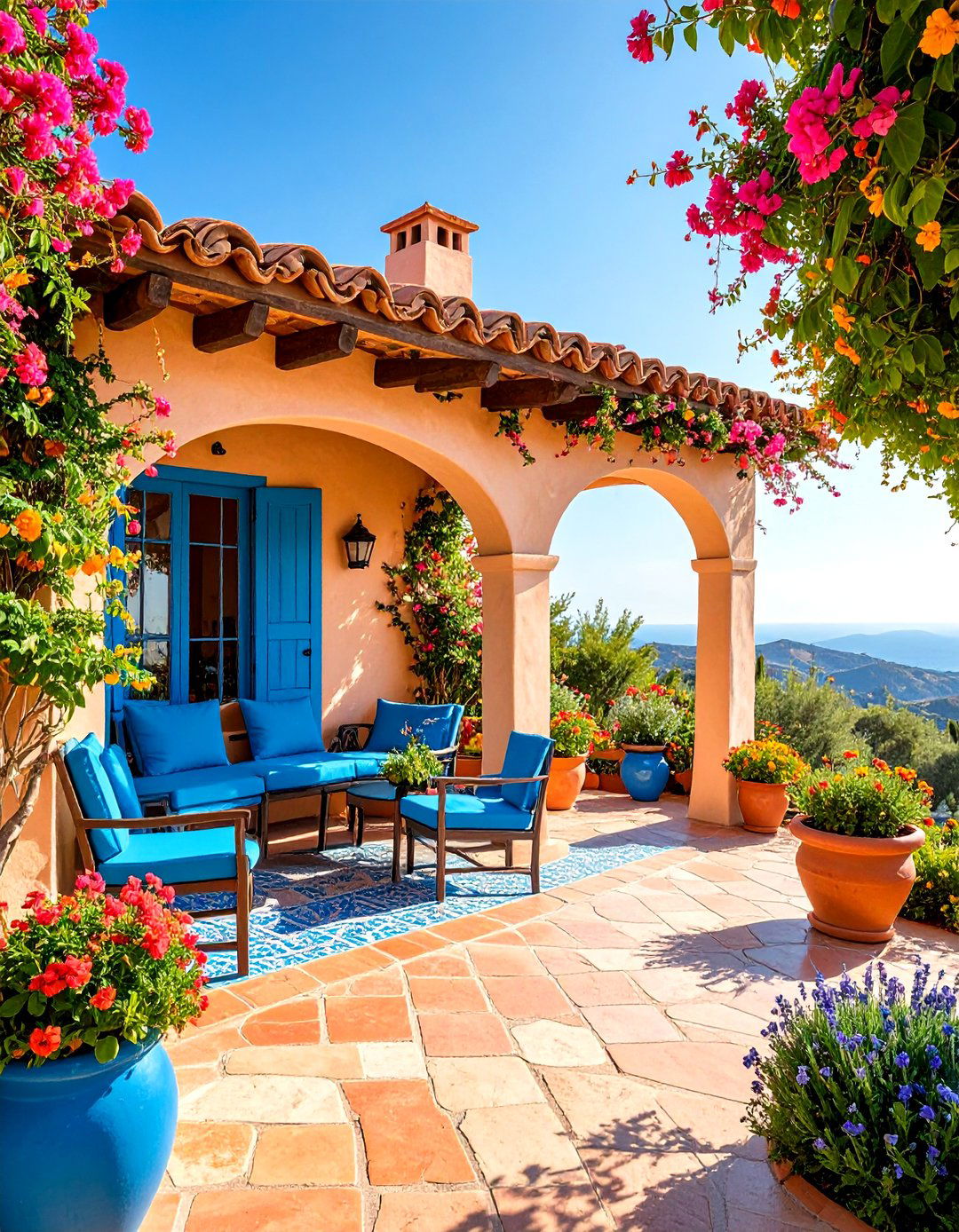
Separate guest quarters embrace Spanish Mediterranean design principles through scaled-down architecture that provides privacy and comfort for visiting family and friends. These small structures feature authentic materials including stucco walls, tile roofing, and decorative elements that complement the main house while maintaining distinct character. Efficient floor plans maximize limited space through built-in storage, multi-functional furniture, and strategic window placement that promotes natural light and cross-ventilation. Kitchenette areas, bathroom facilities, and sleeping quarters provide complete accommodations while maintaining intimate scale appropriate for temporary occupancy. Outdoor spaces including private patios or covered porches extend living areas while maintaining connections to landscape and main house activities. These guest houses serve multiple purposes including home offices, art studios, or rental units that provide additional income opportunities. Careful siting considers privacy, views, and access while maintaining overall property harmony through consistent architectural vocabulary and landscape integration.
22. Spanish Mediterranean Wine Cellar and Tasting Room
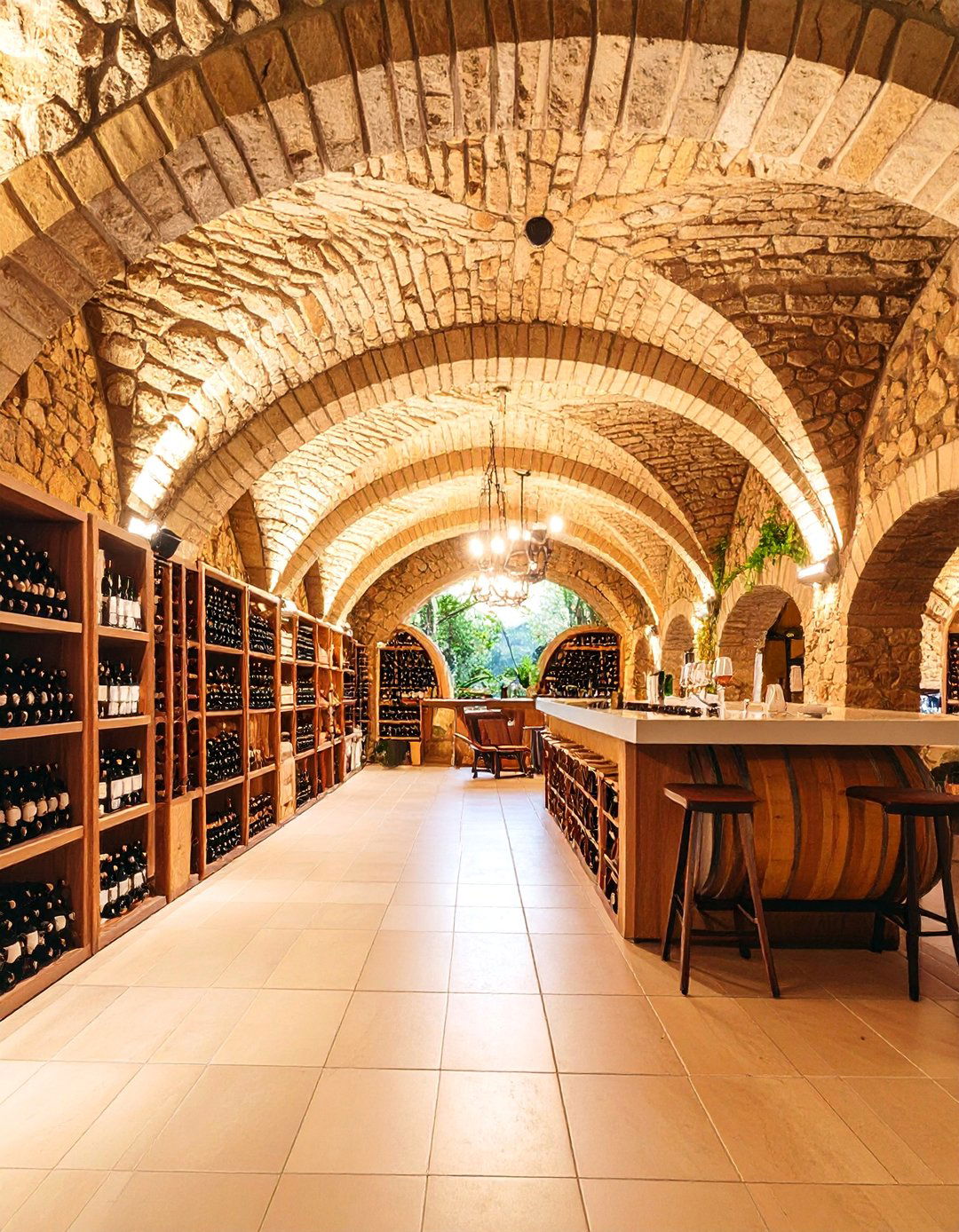
Dedicated wine storage and tasting spaces reflect Spanish Mediterranean culture's celebration of wine-making traditions and leisurely entertaining. These below-grade or interior rooms feature climate-controlled environments, stone walls, and arched ceiling designs that provide optimal storage conditions while maintaining architectural authenticity. Custom millwork including wooden racks, tasting bars, and display areas showcase wine collections while providing functional workspace for serious collectors. Natural materials including stone flooring, exposed beams, and decorative tile accents create atmospheric settings perfect for intimate tastings and special occasions. Proper lighting design balances task illumination for reading labels with ambient lighting that creates warm, inviting atmosphere for social gatherings. Ventilation systems maintain proper humidity and temperature while preventing mold and other storage issues. These specialized spaces add significant value while providing unique entertainment venues that celebrate Mediterranean lifestyle and cultural traditions.
23. Moroccan-Influenced Spanish Tile Work
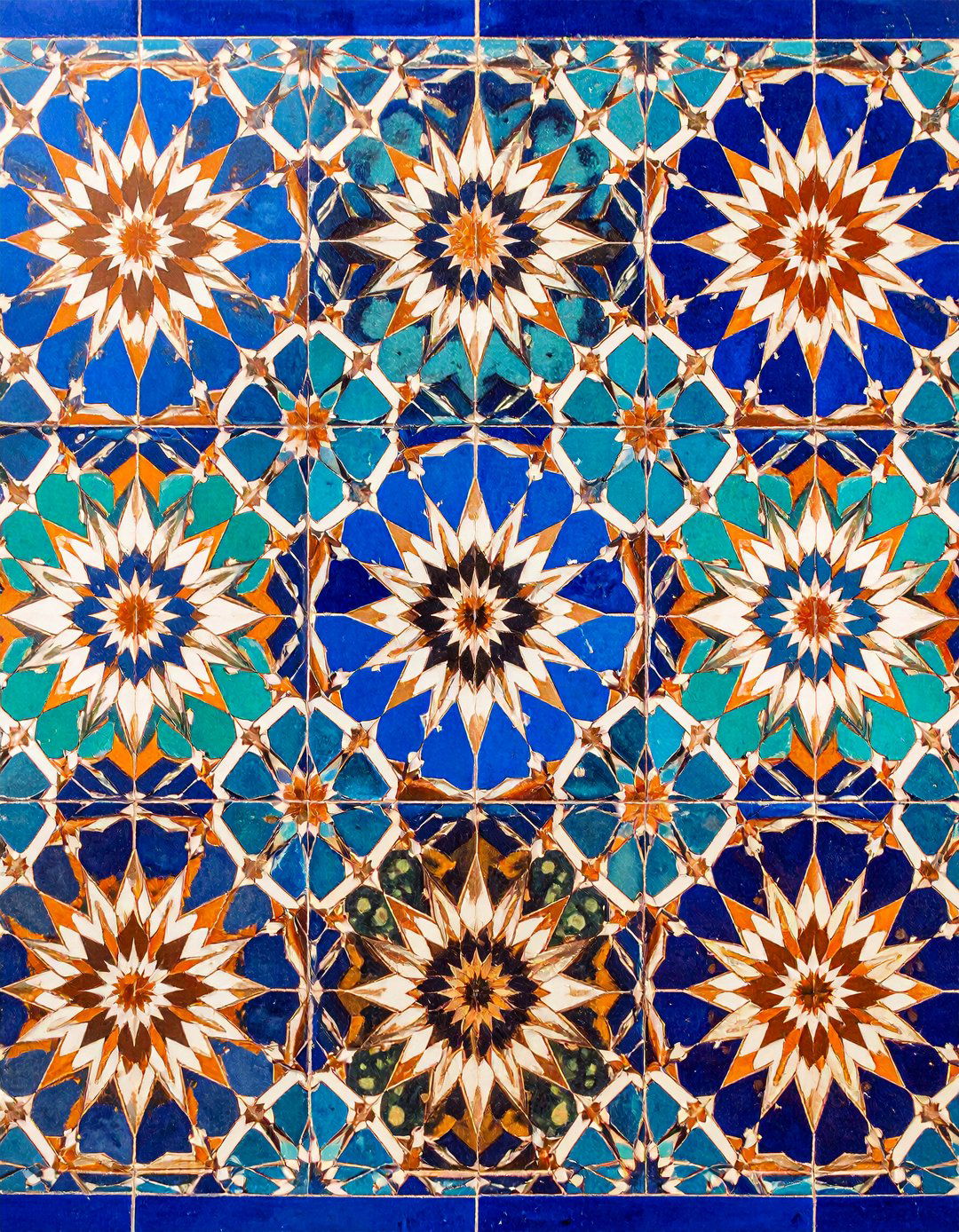
Intricate geometric tile patterns reflect the rich Moorish heritage that significantly influenced Spanish Mediterranean design traditions. These complex installations appear in fountain surrounds, stair risers, fireplace designs, and accent walls that showcase mathematical precision and artistic beauty. Traditional patterns including star-and-cross motifs, interlacing designs, and calligraphic elements create visual richness while honoring centuries-old artistic traditions. Color combinations typically feature deep blues, emerald greens, warm golds, and crisp whites that create striking contrast and visual depth. Modern applications may simplify traditional patterns or use contemporary materials while maintaining the essential geometric character and cultural significance. These installations require skilled craftspersons familiar with traditional techniques and pattern development. Proper substrate preparation, layout planning, and installation methods ensure lasting beauty and structural integrity. These decorative elements provide unique character that distinguishes Spanish Mediterranean homes while celebrating the multicultural heritage that shaped this beloved architectural style.
24. Spanish Colonial Dining Room Elegance
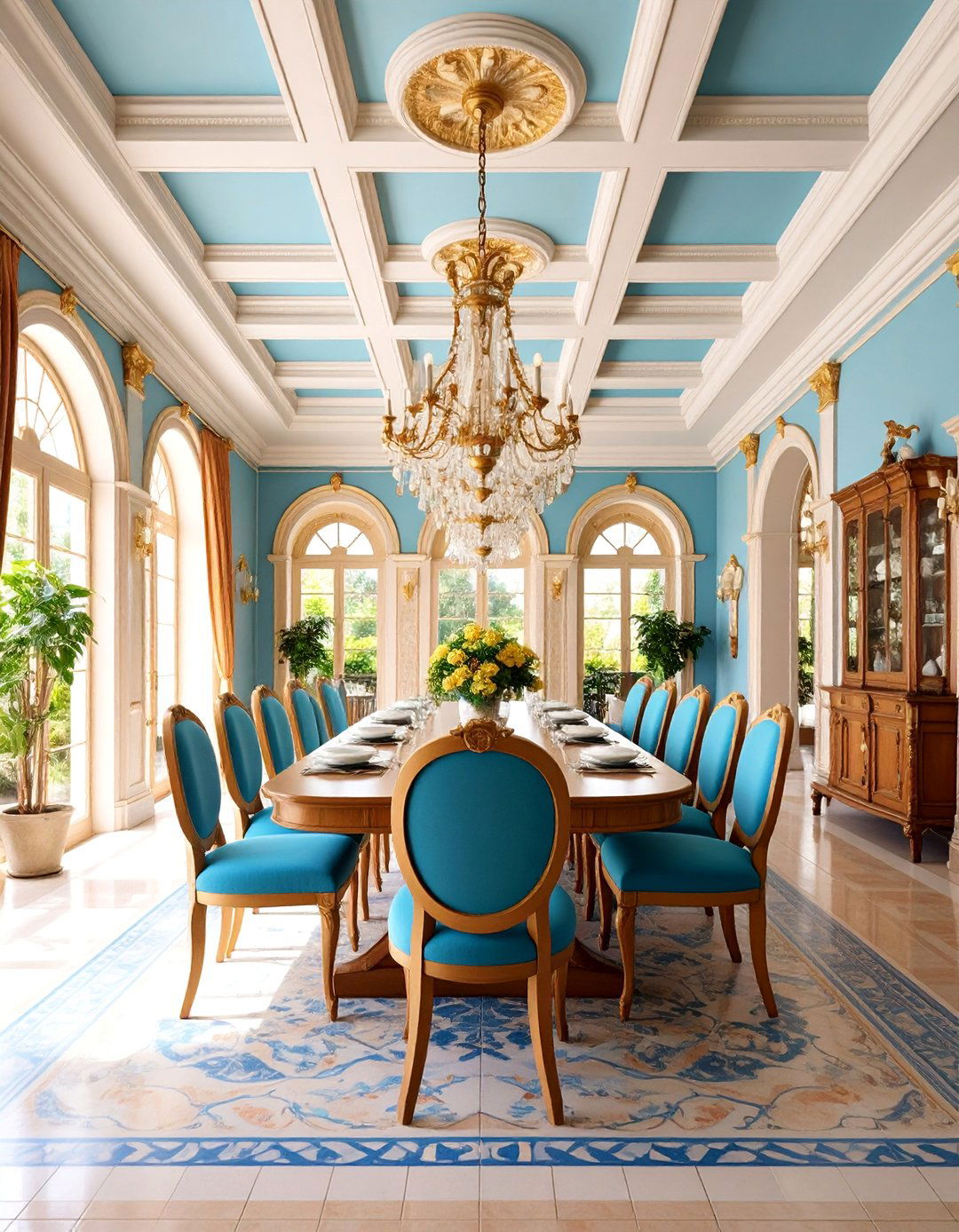
Formal Spanish Mediterranean dining rooms combine traditional architectural elements with sophisticated furnishing choices that create memorable spaces for special occasions and family gatherings. Coffered or beamed ceilings, textured plaster walls, and tile or stone flooring provide authentic architectural foundation for carefully chosen furniture and decorative elements. Large wooden dining tables, upholstered chairs with carved details, and traditional serving pieces reflect Spanish craftsmanship traditions while accommodating modern entertaining needs. Built-in china storage, wine displays, and serving areas provide practical functionality while maintaining aesthetic continuity with overall design themes. Natural light enters through arched windows while decorative lighting including wrought iron chandeliers and wall sconces create layered illumination perfect for intimate dinners and festive celebrations. These formal spaces balance elegance with comfort, creating environments that honor Spanish cultural traditions while serving contemporary lifestyle requirements and entertaining preferences.
25. Modern Spanish Mediterranean Smart Home Integration

Contemporary Spanish Mediterranean homes seamlessly blend traditional aesthetics with cutting-edge technology through carefully planned smart home systems that enhance comfort, security, and energy efficiency. Hidden wiring, wireless controls, and discrete device placement maintain authentic architectural character while providing modern conveniences including automated lighting, climate control, and entertainment systems. Solar panels integrated into traditional tile roofing reduce energy consumption while maintaining visual harmony with Spanish architectural elements. Smart irrigation systems support drought-tolerant landscaping while minimizing water waste and maintenance requirements. Security systems including cameras, sensors, and access controls provide peace of mind while remaining virtually invisible within traditional design elements. Home automation allows remote control of various systems while programmable features optimize energy usage and comfort levels. These technological improvements enhance property value while supporting sustainable living practices that align with Mediterranean environmental consciousness and modern homeowner expectations.
Conclusion:
Spanish Mediterranean house design continues captivating homeowners through its timeless blend of architectural beauty, cultural richness, and lifestyle-focused functionality. These 25 ideas demonstrate the style's versatility, from traditional hacienda aesthetics to contemporary smart home integration, proving that Mediterranean design principles adapt beautifully to modern living requirements. Whether embracing authentic materials like hand-painted tiles and wrought iron details or incorporating sustainable technologies and drought-resistant landscaping, these homes celebrate indoor-outdoor living while honoring centuries of architectural tradition. The enduring appeal lies in creating spaces that prioritize comfort, beauty, and connection to nature—values that remain constant across generations and continue inspiring homeowners seeking both elegance and livability.


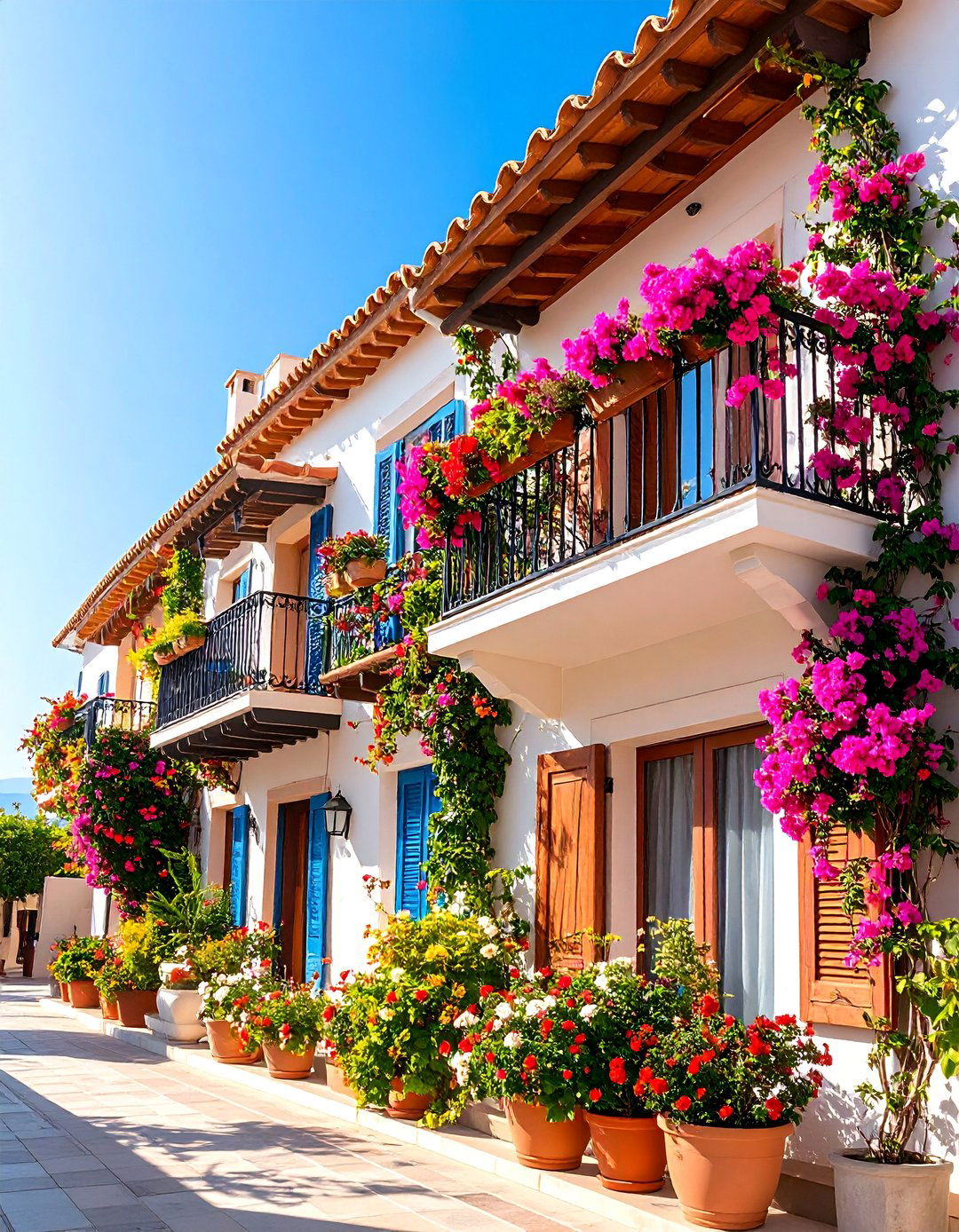




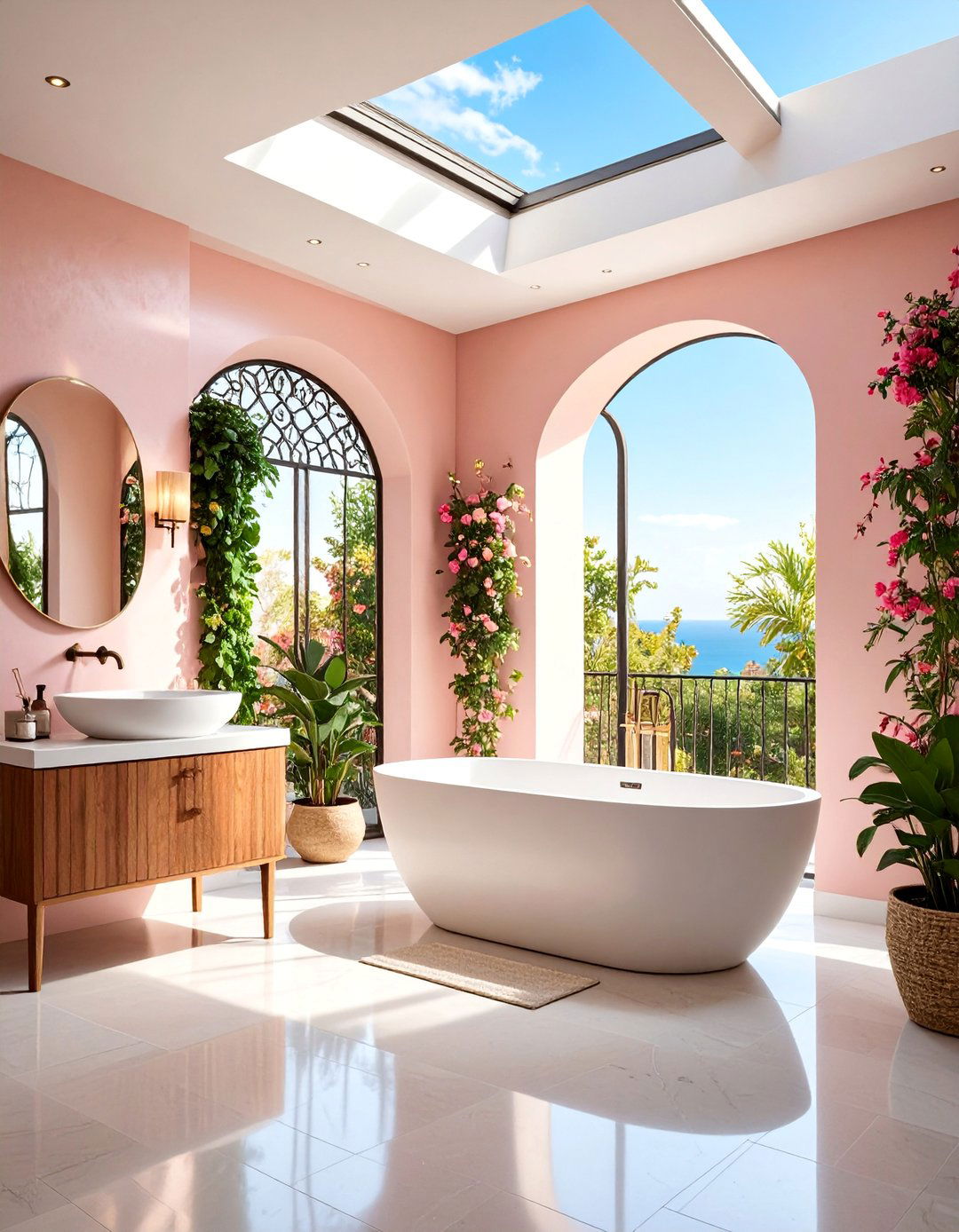
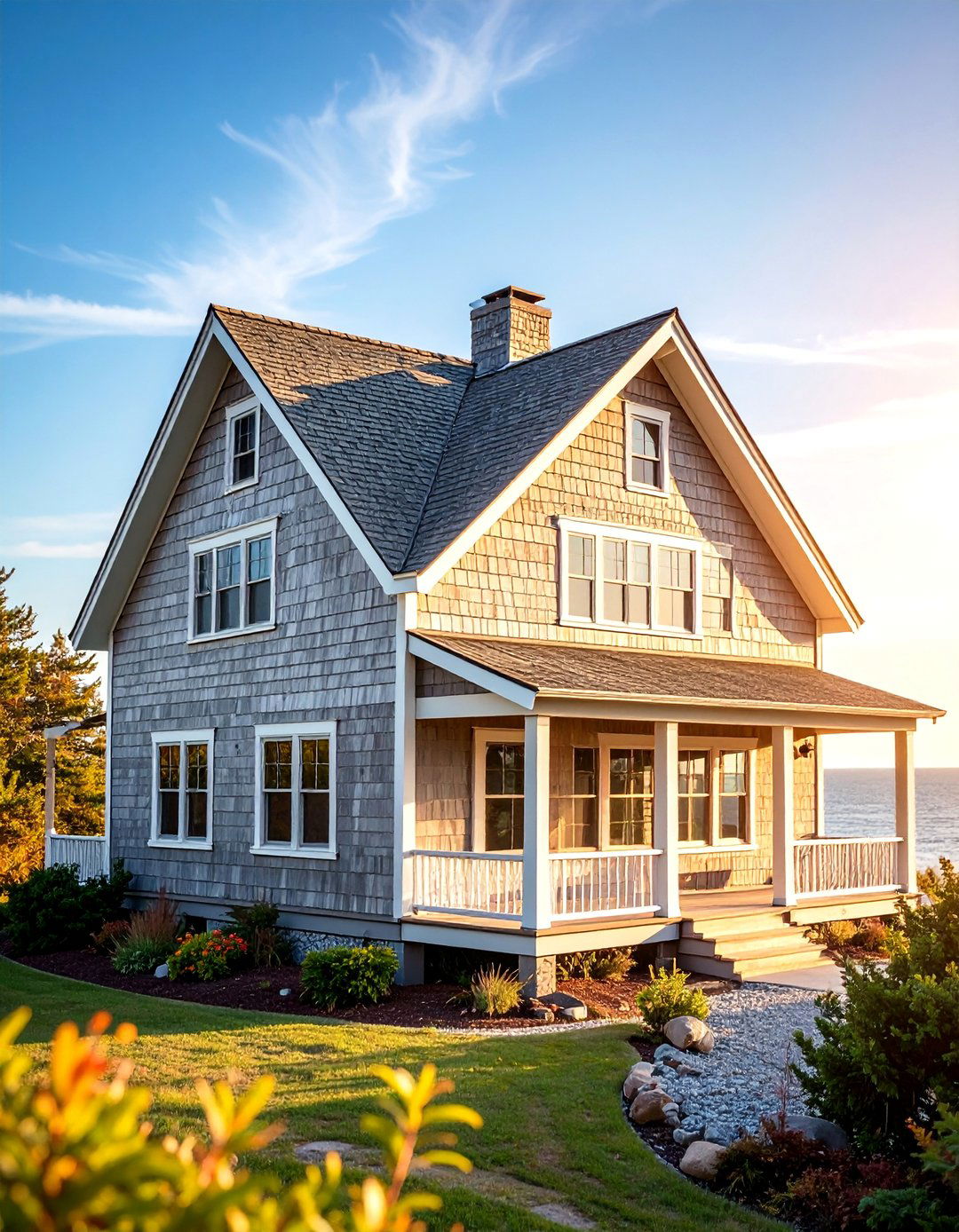




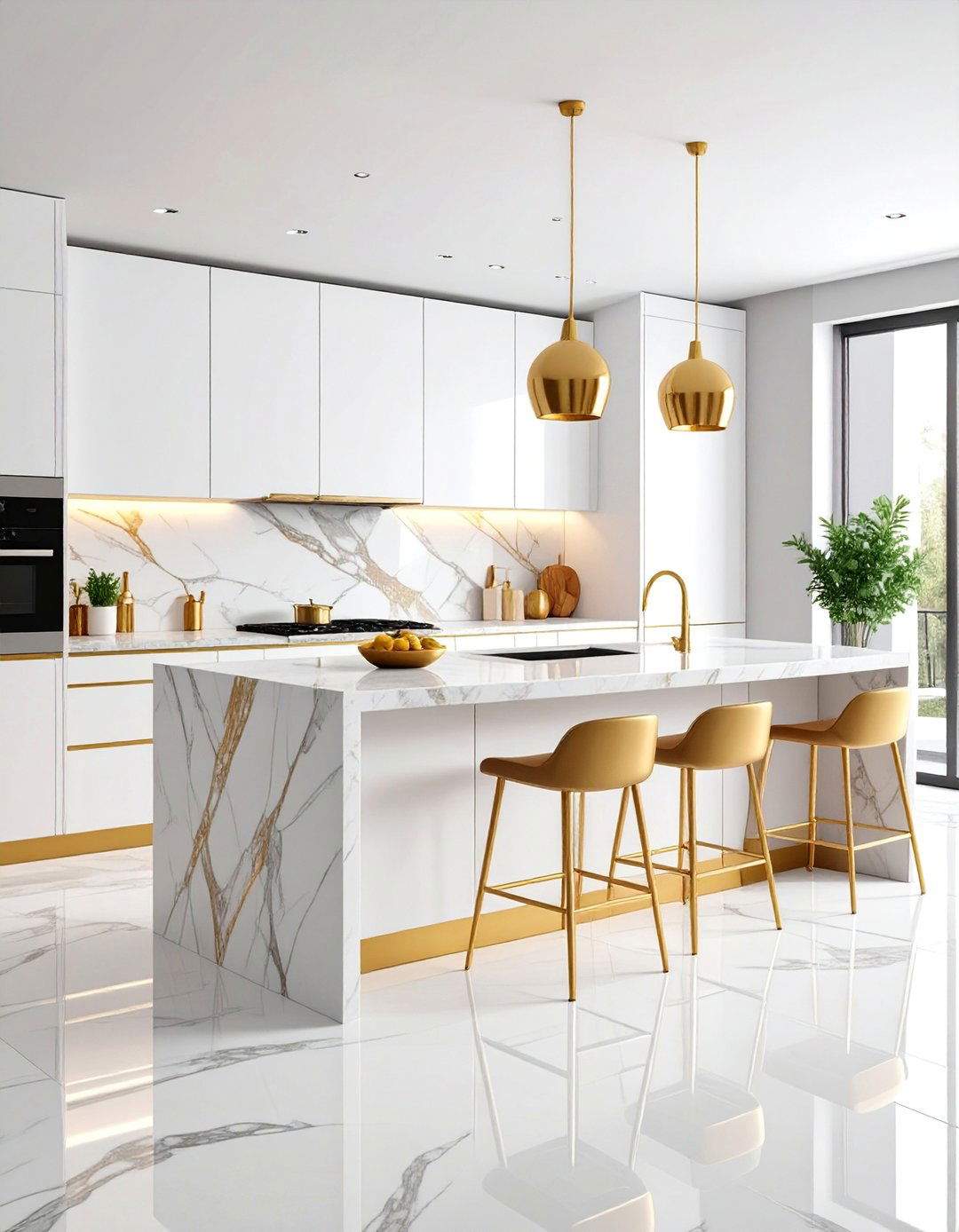
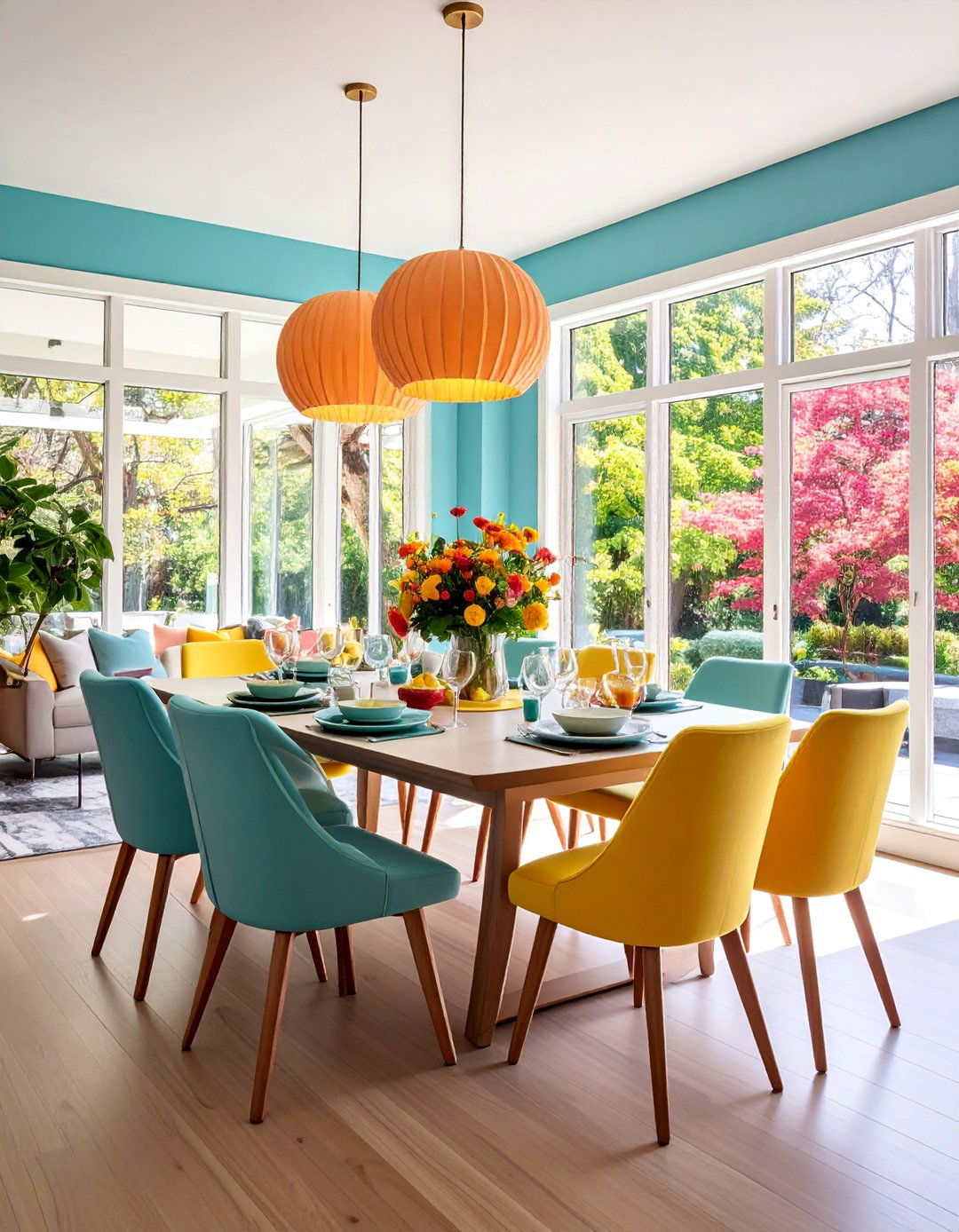
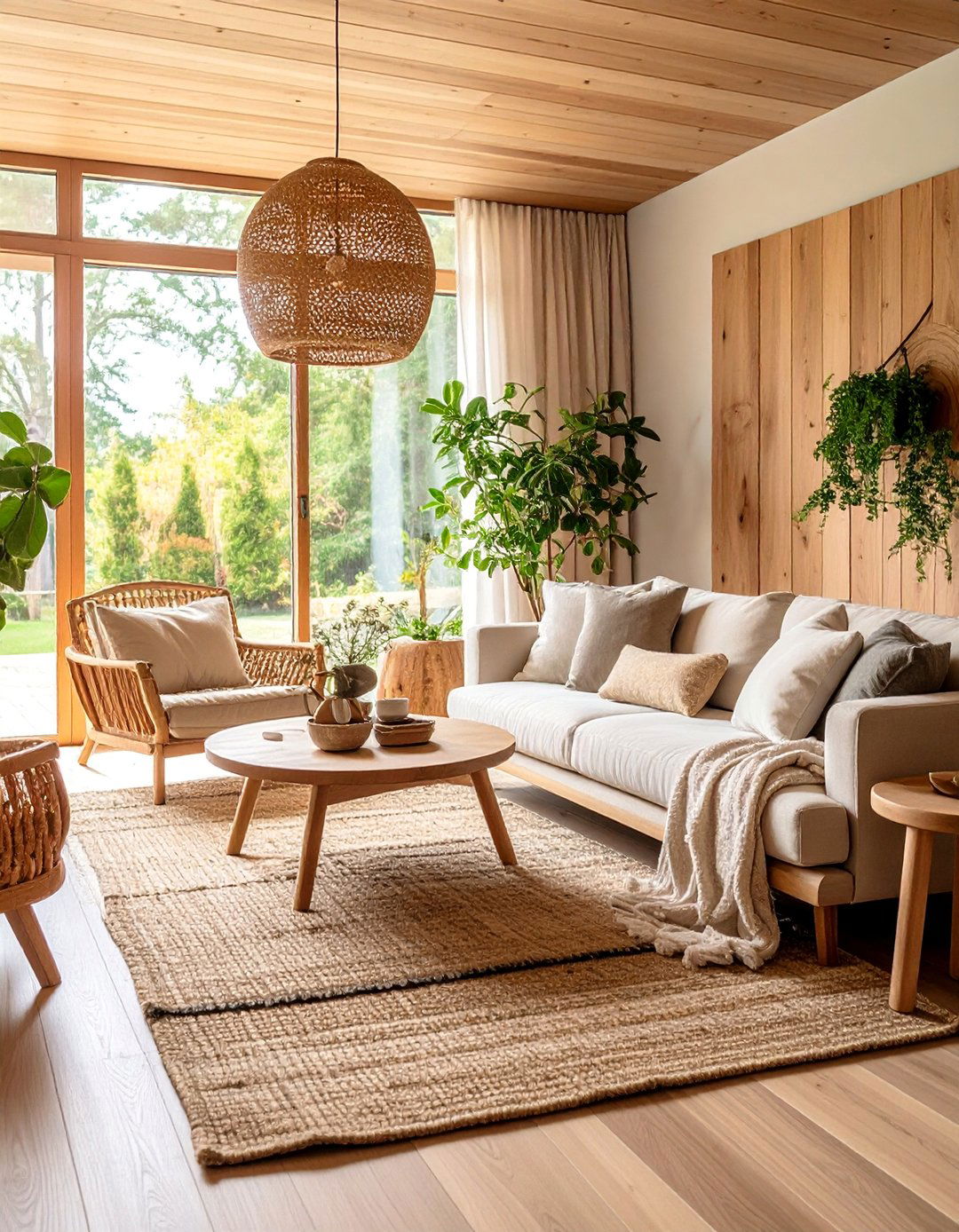

Leave a Reply